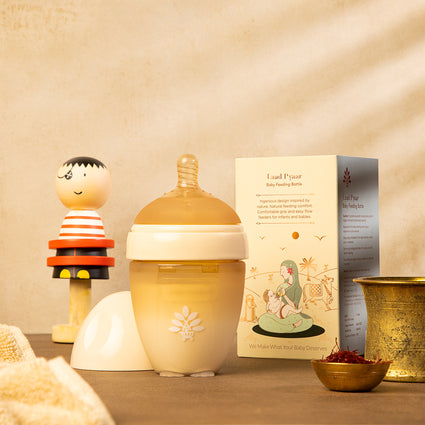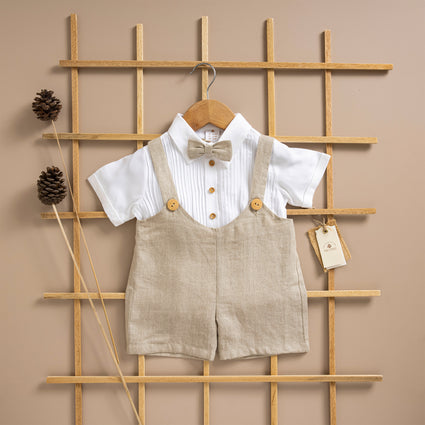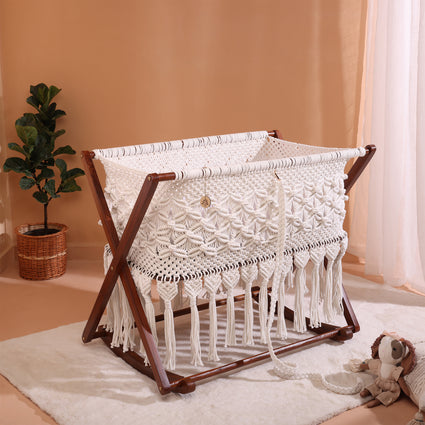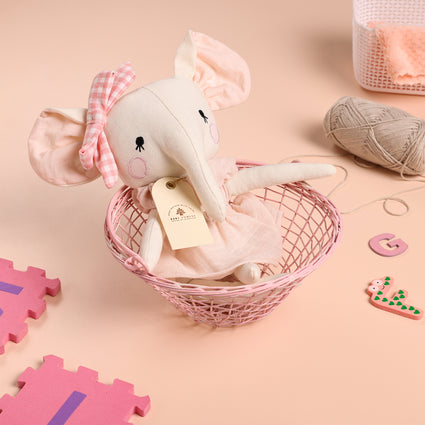Baby Care & Parenting Blogs
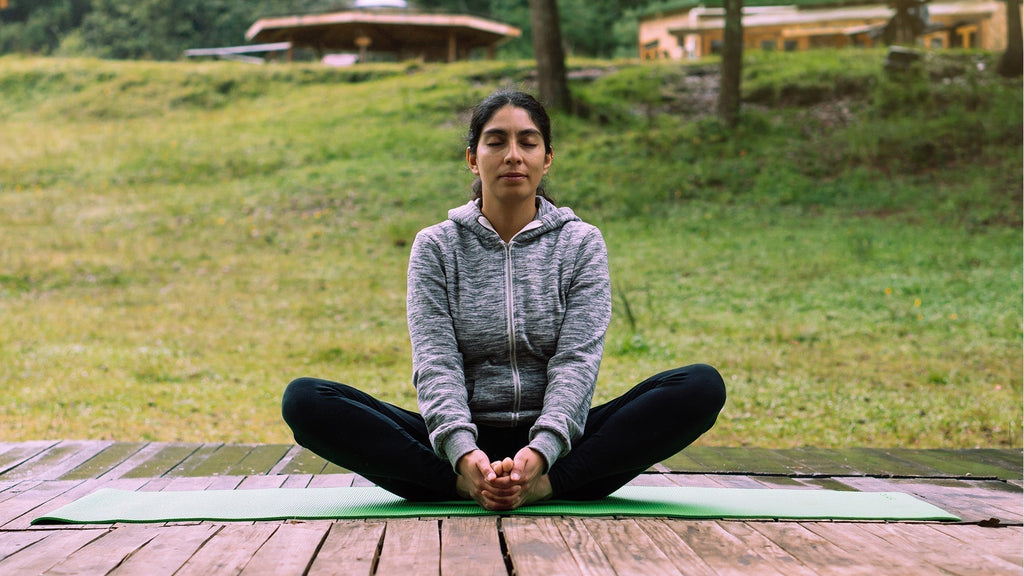
Fertility Yoga for Beginners: A Step-by-Step Guide
Trying to conceive can be an emotional rollercoaster. The waiting, the stress, the well-meaning (but sometimes overwhelming) advice—it's a lot. If you're looking for a natural way to support your fertility and bring some calm into the process, fertility yoga might be just what you need. It's a gentle, mindful practice that helps melt away stress, improves blood flow to your reproductive organs, and brings a sense of balance to your body and mind.
The best part? You don't need to be a yoga pro to start. Yoga for conceiving is all about simple, nurturing movements that make you feel good—physically and emotionally. This guide will walk you through the basics so you can step onto your mat with confidence and start your journey with ease.
How Yoga Supports Fertility
You might be wondering—how exactly does yoga help with fertility? The benefits go beyond just stretching and relaxation.
Reduces Stress:
Stress is a big factor in fertility struggles. Yoga helps calm the nervous system, reducing cortisol levels and promoting a state of relaxation that's essential for conception.
Improves Blood Circulation:
Certain poses enhance blood flow to the reproductive organs, helping to nourish and support them.
Balances Hormones:
By stimulating the endocrine system, yoga can help regulate hormones crucial for ovulation and overall reproductive health.
Strengthens the Pelvic Area:
Many yoga poses target the hips, pelvis, and lower abdomen, creating a strong and supportive foundation for pregnancy.
Encourages Mind-Body Connection:
Yoga teaches you to be more in tune with your body, making it easier to recognize your natural cycles and fertility signals.
Best Time to Start Fertility Yoga
The short answer? Anytime! There's no right or wrong time to start, but if you're actively trying to conceive, incorporating yoga for conceiving into your routine before ovulation can be extra beneficial.
If you're undergoing fertility treatments, it's always a good idea to check with your doctor about when and how to practice. Some women find that gentle yoga works well throughout their entire cycle, while others prefer to adjust the intensity based on how they're feeling. Listen to your body, take it slow, and let yoga support you every step of the way!
Related Read - About Beej Sanskar
Essential Tips for Beginners
Starting something new can feel intimidating, but don't worry. Here are a few tips to ease into fertility yoga:
Keep It Gentle:
Fertility yoga is all about relaxation and connection. Avoid intense, high-impact yoga styles.
Breathe Deeply
Focus on slow, deep breaths. This helps reduce stress and increases oxygen flow to your reproductive organs.
Listen to Your Body:
If a pose feels uncomfortable, skip it. Yoga should feel good, not forceful.
Create a Calm Space:
Find a quiet spot where you feel at ease. A soft mat, dim lighting, and relaxing music can set the mood.
Stay Consistent:
Like anything, consistency matters. Aim for at least 3-4 sessions a week to see benefits.
Step-by-Step Fertility Yoga Routine
Here's a simple routine to get you started. These poses are gentle, effective, and beginner-friendly.

1. Butterfly Pose (Baddha Konasana)
-
Sit on the floor with your spine tall.
-
Bring the soles of your feet together, letting your knees drop outward.
-
Hold your feet and gently press your knees toward the floor.
-
Stay here for 3-5 minutes, breathing deeply.
Why it helps: It opens up the hips and increases circulation to the pelvic area.
2. Legs Up the Wall (Viparita Karani)
-
Lie on your back and extend your legs up against a wall.
-
Relax your arms by your sides and breathe deeply.
-
Hold for 5-10 minutes.
Why it helps: Encourages blood flow to the reproductive organs and promotes relaxation.
3. Child's Pose (Balasana)
-
Kneel on the floor and sit back on your heels.
-
Extend your arms forward and rest your forehead on the mat.
-
Breathe deeply and stay here for 3 minutes.
Why it helps: It releases tension in the lower back and hips and reduces stress.
4. Bridge Pose (Setu Bandhasana)
-
Lie on your back with your knees bent and feet flat on the floor.
-
Press your feet into the mat and lift your hips up.
-
Hold for 30 seconds, then lower slowly.
Why it helps: Stimulates the pelvic region and balances hormones.
5. Seated Forward Bend (Paschimottanasana)
-
Sit with legs extended forward.
-
Reach for your toes, folding over your legs.
-
Hold for 3 minutes while breathing deeply.
Why it helps: It improves blood circulation to the uterus and relieves stress.
Additional Lifestyle Tips to Boost Fertility
Along with yoga for conceiving, a few lifestyle changes can further support your journey:
Eat a Balanced Diet:
Focus on whole, nutrient-rich foods like leafy greens, nuts, seeds, and lean proteins.
Stay Hydrated:
Proper hydration supports overall reproductive health.
Get Enough Sleep:
Aim for 7-9 hours of quality sleep to keep hormones balanced.
Reduce Caffeine and Alcohol:
Both can interfere with hormone regulation and ovulation.
Practice Mindfulness:
Meditation and breathing exercises can further reduce stress and improve emotional well-being.
Precautions and When to Consult a Doctor
Fertility yoga is generally safe, but tuning into your body is key. If you have a medical condition, have had recent surgery, or are undergoing fertility treatments, it's always best to check with your doctor before starting.
And remember—yoga for conceiving should feel good, not painful. If any pose feels uncomfortable or causes strain, don't push through it. Modify, take a break, or switch to a gentler pose. Your body knows best, so let it guide you!
Conclusion
Fertility yoga is more than just movement—it's a way to nurture your body, mind, and fertility all at once. It melts away stress, boosts blood flow to your reproductive organs, and creates a positive, welcoming space for new life to grow.
By making yoga for conceiving a part of your routine—alongside a healthy lifestyle—you're giving yourself the best possible chance to embrace this beautiful journey. So, roll out your mat, take a deep breath, and trust the process. Your body is working with you every step of the way!
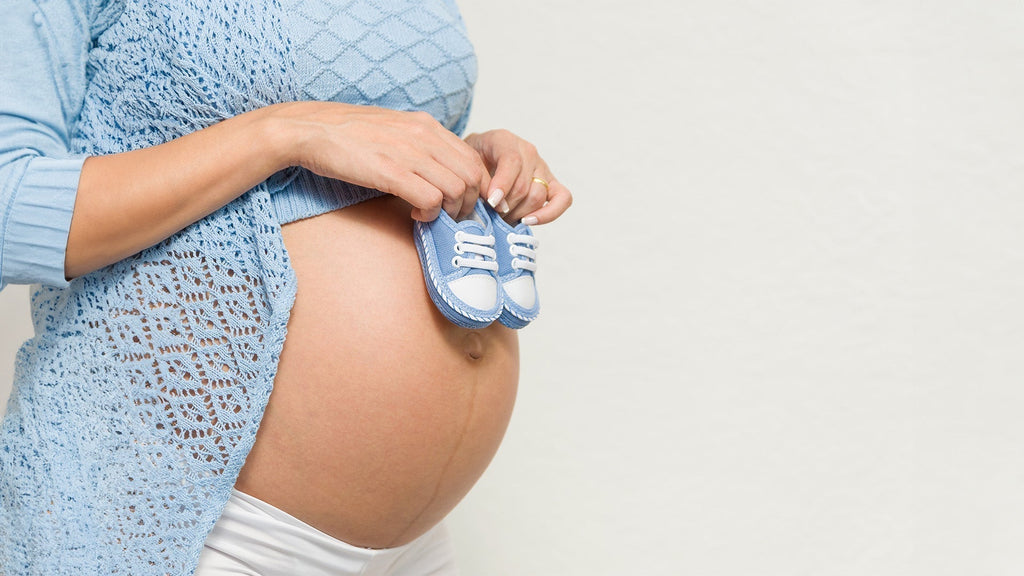
Gas Bubbles or Baby Kicks? How to Tell the Difference Dur...
Pregnancy is full of surprises! One moment, your belly feels quiet, and the next—there's a weird little flutter. Could it be your baby moving, or is it just gas? Every first-time mom wonders the same thing!
The early flutters of pregnancy can feel surprisingly similar to digestion-related movements, making it tricky to tell what's what. But don't worry—understanding the difference between gas bubbles and baby moving will help you connect with your little one and recognize key pregnancy milestones.
Let's break it down in a simple, no-stress way!
Understanding Quickening: The First Baby Movements
Quickening is that magical moment when you first feel your baby move—an exciting milestone that usually happens between 16 and 25 weeks of pregnancy. But here's the tricky part: those first little flutters can be super subtle and easy to mistake for something else.
At first, baby kicks might feel like tiny bubbles popping, a soft tickle, or even little muscle spasms. Some moms say it's like butterflies in their belly! But don’t worry—soon enough, those movements will get stronger and more distinct, making it much easier to tell when your little one is saying hello.
Related Read - When Can You Feel Your Baby Kick?
What Do Gas Bubbles Feel Like
Gas bubbles are totally normal during pregnancy (thanks, hormones!). Since digestion slows down, trapped air can create sensations that feel surprisingly like baby kicks. You might notice:
-
A rolling or gurgling feeling in your stomach
-
Quick, popping sensations that come and go
-
Pressure that shifts and disappears after passing gas
The key difference? Gas is often paired with bloating or bowel changes, while baby kicks become more rhythmic and responsive over time. If you’re unsure, try eating, resting, or gently poking your belly—your little one might just say hello!
Key Differences Between Gas Bubbles and Baby Kicks
So, how do you tell if it's gas or your baby making moves? Let's break it down!
Location Matters
Baby kicks usually happen lower in your belly, right where your uterus is growing. Gas bubbles can pop up anywhere in your stomach or intestines.
Pattern and Timing
Gas comes and goes randomly, often after meals. Baby movements tend to follow a pattern, especially as they get stronger over time.
Response to Touch
Try pressing gently on your belly—if you feel movement in response, it's likely your baby is saying hello! Gas won't react the same way.
Accompanying Symptoms
Feeling bloated, crampy, or the urge to pass gas? That's digestion, not your baby.
Consistency
Baby kicks become more predictable as pregnancy progresses, while gas is just... unpredictable.
Understanding the difference between gas bubbles and baby moving helps you relax and enjoy this special part of pregnancy!
When to Expect Baby Kicks
If you're a first-time mom, you'll probably start feeling those tiny kicks between 18-25 weeks. If you've been pregnant before, you might recognize them even earlier—sometimes around 16 weeks! But don't stress if you don't feel movement right away.
Things like placenta placement, baby's position, and even body shape can all affect when you first notice those little flutters. As your pregnancy moves along, those movements become stronger and more obvious. By the third trimester, get ready for jabs, rolls, and even little baby hiccups—it's all part of the magic!
How to Encourage Baby Kicks
Eager to feel those tiny feet in action? Try these fun little tricks to get your baby moving!
Grab a snack
A little fruit or juice can give your baby a mini sugar rush, making them more active.
Lie down and relax
Babies love to move when you're still, so try lying on your side and pay close attention.
Give a gentle nudge
A soft belly rub, or poke might just get a response!
Play some tunes
Your baby can hear sounds in the womb, and some even "dance" (okay, wiggle) to music or your voice.
Change positions
Adjusting how you sit or lie down might encourage movement—like helping them find their favourite cozy spot!
Savor these little moments—before you know it, those tiny flutters will turn into big, undeniable kicks!
When to Talk to Your Doctor
At first, baby movements can be all over the place, but by the third trimester, you'll start noticing a pattern. If you ever feel unsure, trust your instincts!
Call your doctor if:
-
You haven't felt any movement for 25 weeks.
-
Your baby's movements suddenly slow down or stop.
-
There's a significant decrease in activity after 28 weeks.
A quick check-up can bring peace of mind and make sure everything is going smoothly. When in doubt, reach out—it's always better to be safe!
Conclusion
Feeling movement inside your belly is pure magic! But in the early weeks, it's totally normal to wonder—is that a baby kick or just gas? The trick is to notice where you feel it, how often it happens, and if it responds to touch.
With time, you'll start recognizing your baby's little patterns and cherish these tiny moments of connection. Knowing the difference between gas bubbles and baby moving can ease worries and make pregnancy even more exciting. So, take a deep breath, trust your body, and enjoy this incredible journey!

How to Encourage Your Baby to Take Their First Steps
Watching your baby take their first steps is one of the most exciting moments as a parent. It's a memory you'll hold onto forever! But, as a new parent, you might ask yourself, when do babies start walking? Well, the timing can vary from baby to baby.
Knowing a bit about the typical development process and how to support your little one can help them confidently take those first steps. So, let's talk about how you can encourage your baby to walk and share some tips to make the journey smoother for both of you!
Understanding When Babies Typically Start Walking
Before we delve into the tips and tricks, let's answer a question many parents have: when do babies start walking? Generally, most babies take their first steps somewhere between 9 to 12 months. But here's the thing—some babies might walk earlier, while others take their time. It's all part of their unique development. Some little ones may even skip crawling entirely, while others might crawl for a few months before walking.
In the early months, your baby is busy learning to roll over, sit, and stand—these are all important building blocks for walking. As they approach their first birthday, you'll likely notice them more interested in standing and moving around. But hey, if your baby isn’t walking exactly on time, don't stress. They're doing just fine as long as they're hitting other milestones!
Signs Your Baby Is Ready to Start Walking
You might notice a few signs that indicate your baby is getting ready to take their first steps. Here are some common ones:
-
Pulling themselves up to stand:
If your baby is starting to pull themselves up on furniture or your legs, that's a great sign. It means they're building strength in their legs and core muscles. -
Cruising along furniture:
As your baby gains more confidence, they may begin to "cruise" or walk while holding onto furniture. This is a key step in the transition to walking independently. -
Standing for longer periods:
When your baby can stand without support, even for just a few seconds, it shows they're gaining balance and stability.
-
More interest in moving:
If your baby is eager to explore and tries to take steps while holding onto your hands, they are ready to start walking.
How to Encourage Your Baby to Walk
The best way to encourage your baby to walk is to create an environment where they can practice safely and comfortably. Here are some simple and effective ways to help them along the way:

-
Provide plenty of tummy time:
Tummy time is essential for building the muscles your baby needs to roll, crawl, and eventually walk. It helps strengthen their arms, shoulders, and neck, preparing them for more complex movements like standing and walking. -
Support them in standing:
Help your baby practice standing by holding their hands and guiding them to stand. Don't be afraid to let them bear some of their own weight, as this helps develop the leg muscles needed for walking. -
Encourage cruising:
Place toys or objects just out of reach on low furniture, encouraging your baby to cruise while holding onto the furniture. This helps them build balance and coordination. -
Create a safe walking space:
As your baby starts to take steps, make sure they have a safe environment to practice. Use soft rugs or mats and remove any sharp objects or obstacles that could cause accidents. -
Show them how it's done:
Babies love to imitate, so demonstrate walking by holding their hands and walking with them. You can also encourage them by showing excitement when they make even the smallest steps.
Building Physical Strength for Walking
To ensure your baby is physically ready for walking, focus on activities that help strengthen their muscles. Here are some simple ways to promote physical development:
-
Encourage crawling:
Crawling helps build core and arm strength, both essential for walking. If your baby isn’t crawling yet, give them plenty of floor time to encourage it. -
Use baby walkers (with caution):
While baby walkers can be fun, they aren't recommended for everyday use. They can limit the development of walking skills and might even cause safety issues. Instead, let your baby practice standing and walking with your guidance. -
Give them opportunities to climb:
If your baby is showing interest in climbing, encourage it in a safe, supervised way. Climbing helps improve coordination, strength, and balance.
Common Challenges and How to Address Them
As your baby begins to walk, they may face a few challenges. Here are some common ones and tips on how to address them:
-
Fear of falling:
It's completely normal for your baby to be hesitant about walking at first. To help, encourage them gently, and offer praise when they try. Support them without pushing too hard.
-
Wobbliness and falls:
Expect plenty of falls as your baby learns to balance. Ensure they are walking in a safe space, and don't worry too much about the occasional tumble—it's all part of the learning process. -
Delayed walking:
If your baby is taking longer to walk than you expected, try not to stress. Some babies take a little longer. As long as they are meeting other developmental milestones, they are likely just taking their time.
What to Avoid
While encouraging your baby to walk, it's essential to avoid certain practices that could hinder their progress:
-
Skipping crawling:
While some babies may skip crawling, it's an important stage in developing motor skills. Avoid pushing your baby to skip this step too early. -
Rushing the process:
Every baby develops at their own pace. Avoid comparing your baby to others. The most important thing is that they are happy, healthy, and progressing in their own way.
When to Consult a Doctor?
In most cases, there's really no need to worry if your baby isn't walking exactly on time. However, if your little one isn't showing any interest in standing or walking by 18 months, it might be a good idea to talk to your paediatrician. Sometimes, delayed walking can signal an underlying issue but remember—every baby develops at its own pace, so a little extra time is often just part of the process.
Conclusion
Encouraging your baby to take their first steps is such a rewarding experience—full of excitement and joy! So, when do babies start walking? The answer can vary, but with the right support and a little patience, your baby will eventually take those first wobbly steps. The key is to create a safe, supportive environment and allow your baby to explore at their own pace. With plenty of love, encouragement, and some fun along the way, your baby will be walking in no time!

Immunization 101: Everything Parents Need to Know About V...
As a new parent, you want to do everything you can to protect your little one. One of the best ways to keep them safe and healthy is through Immunization Education. Vaccines are important because they help prevent serious diseases and ensure your baby's health. But with all the information, it can feel overwhelming. Don't stress – we've got you covered! We'll break it all down for you in simple, easy-to-understand terms so you can make the best choices for your baby's health.
What Is Immunization and How Does It Work?
Immunization is all about protecting your little one from harmful diseases using vaccines. Think of it like giving your child a "training session" for their immune system. When they get a vaccine, a tiny, harmless piece of the disease is introduced into their body. This helps their immune system learn how to recognize and fight off the disease if it ever shows up.
It's like giving your baby a superhero shield that helps them stay strong and healthy. The best part? It's safe, simple, and incredibly effective. So, you're giving your child the tools they need to stay healthy, all while keeping things easy for you!
Why Are Vaccines Important?
Vaccines are super important because they protect your baby from diseases that can cause serious harm or even be life-threatening. Diseases like measles, polio, and whooping cough are no joke, especially for babies who have weaker immune systems. By getting vaccinated, you're not just protecting your baby – you’re also helping to keep the whole community safe.
This is especially important for those who can't be vaccinated, like babies who are too young for certain shots or kids with health conditions that make vaccinations risky.
So, think of it this way: every vaccine your child gets is like a little shield, making them less likely to get sick. And the more vaccinated kids, the stronger that shield becomes for everyone. It's a win-win!
Recommended Immunization Schedule for Children
Vaccines aren't all given at once – they're spaced out over your baby's first few years to ensure they get the best protection at the right times. The schedule is carefully designed to keep your baby safe as they grow.
Here's a quick rundown of the vaccines your baby will get:



This is a general guide, but remember, your paediatrician will give you a more specific schedule based on your baby's needs. You'll always have their expert advice to help you along the way.
Are Vaccines Safe? Addressing Common Concerns
It's normal for parents to have concerns about the safety of vaccines. The good news? Vaccines are incredibly safe. They go through lots of testing before they're approved for use, and even after they're available, they continue to be closely monitored for any issues. Serious side effects are rare; most kids just experience mild symptoms like a sore arm or a slight fever – nothing to worry about.
Some parents also worry that vaccines might overwhelm their baby's immune system, but that's not true. Babies are exposed to thousands of germs daily, and vaccines are just a small part of the immune system's workload. Vaccines help make the immune system stronger, not weaker. So, you can rest easy knowing that vaccines are a safe and smart way to protect your baby's health.
Preparing Your Child for Vaccination
If your child is old enough to understand, it’s a good idea to talk to them about vaccines simply and reassuringly. You can explain that vaccines are like a special shield to help protect their body from getting sick. Let them know that they might feel a quick pinch, but it'll be over in a flash, and it's totally worth it to stay healthy.
For babies, the key is comfort. Use your soothing voice and hold them close to make them feel secure. Bringing a favourite toy or blanket along can also help provide extra comfort during the process. The calmer and more relaxed you are, the more your baby will feel at ease too!
What If You Miss a Vaccine?
Life can get busy, and sometimes appointments get missed – but don't stress! If that happens, most vaccines can still be given, even if they're a little late. All you need to do is call your paediatrician and schedule an appointment as soon as possible. They'll help you get back on track with your baby's vaccine schedule so your little one stays protected. There's no need to worry; your paediatrician will guide you through it.
Questions Parents Commonly Ask About Vaccines
1. Can my baby get sick from a vaccine?
No, vaccines can't make your baby sick. They're made from either inactivated or weakened germs, so they don't cause the disease they're meant to protect against. Any mild symptoms, like a slight fever, are usually short-lived and completely normal.
2. Why does my baby need so many vaccines?
Each vaccine is designed to protect against different diseases, so your baby needs a few different ones to be fully protected. It might seem like a lot, but every vaccine plays an important role in keeping your baby safe from harmful infections.
3. Can vaccines cause autism?
No, vaccines do not cause autism. There has been extensive research on this topic, and it's been shown that there is no link between vaccines and autism. You can feel confident that vaccines are safe for your baby.
When to Call Your Doctor?
After your child gets vaccinated, it's a good idea to keep an eye on them for any unusual reactions. Most side effects are mild, like a sore arm or a slight fever, but if you notice anything concerning, such as a fever over 104°F, a persistent high-pitched cry, or difficulty breathing, it's important to contact your doctor right away. These reactions are rare, but it's always better to be safe and get professional advice if something doesn't seem right.
Conclusion
Vaccination is one of the most powerful tools you have to protect your child from preventable diseases. By following the recommended Immunization Education guidelines, you're giving your baby the best possible start in life. And if you ever have any concerns or questions, don't hesitate to reach out to your paediatrician – they're there to support you every step of the way.
Remember, vaccines aren't just about protecting your little one – they're about building a healthier future for everyone. When your baby gets vaccinated, you’re not only keeping them safe, but you're also helping create a stronger, healthier community for all.
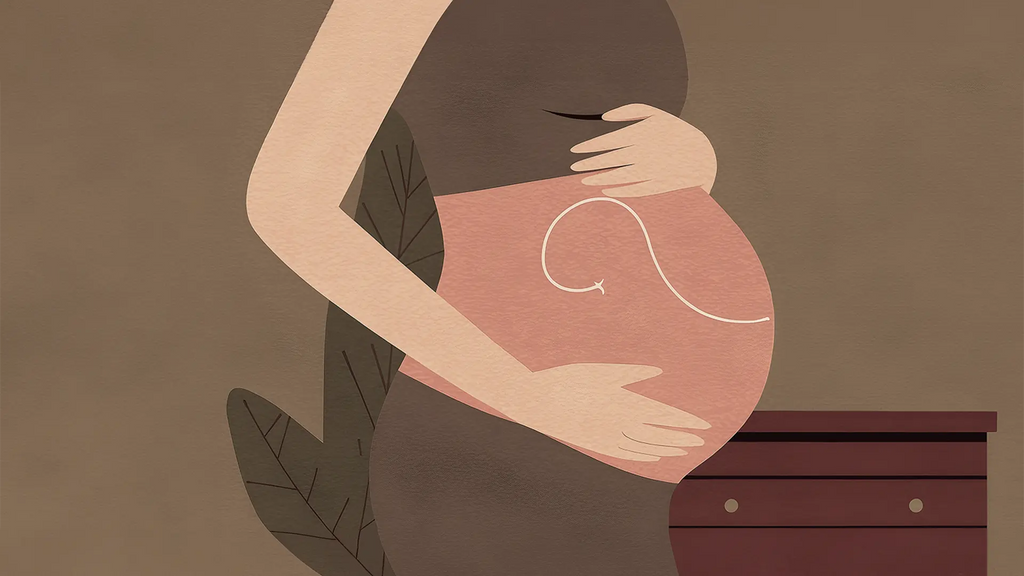
Mucus Plug Color Chart: When to Call Your Doctor During P...
Pregnancy is a beautiful journey, but let's be honest – it can also feel like a rollercoaster of unknowns, especially if you're a first-time parent. One thing that can cause some confusion is the mucus plug. It's completely normal, but when you lose it, a lot of expectant moms start wondering, "What now?" Is it a sign of labor? Should you be worried? In this article, we're going to break down the mucus plug color chart and give you all the info you need to know about when to call your doctor during pregnancy. Let's make this one less thing to stress over!
What is a Mucus Plug?
During pregnancy, your cervix creates a thick mucus that forms a plug, acting as a protective barrier for your baby. It helps keep harmful bacteria out of your uterus, reducing the risk of infection. As your body starts to get ready for labor, this mucus plug will gradually loosen and come out. While it's a sign that your body is preparing for childbirth, the timing and how it happens can be different for everyone. So, while it's a normal part of the process, it doesn't necessarily mean labor is right around the corner.
What Does the Mucus Plug Look Like?
The mucus plug usually looks clear or a bit cloudy and may have a jelly-like or stringy texture. Some women notice it all at once, while others may lose it gradually over a few days or weeks. Its size can vary, from a small blob to something larger, and it tends to look different from pregnancy to pregnancy. You might spot it on your underwear, toilet paper, or even during a bathroom visit. Every pregnancy is unique, so how and when you lose the mucus plug can vary!
Mucus Plug Color Chart: What Each Color Means
Now, let's talk about the mucus plug color chart. The color of the mucus plug can give you important clues about your pregnancy. Here's a breakdown of what different colors may indicate:
-
Clear or White:
This is the most common and normal color for the mucus plug. It's typically a sign that your body is gearing up for labor. However, it doesn't necessarily mean labor is about to start right away. -
Pinkish or Blood-Tinged:
Don't worry too much if your mucus plug has a pink or blood-tinged hue. This could be a sign that your cervix is starting to dilate, which is known as a "bloody show." It's often a good sign that labor could be approaching. But if there's a lot of blood, it’s a good idea to reach out to your doctor. -
Brown:
Brown mucus plug can also indicate that your body is getting ready for labor. It often happens after things like a cervix check or intercourse. The brown color is typically just old blood making its way out of your system. -
Green or Yellow:
If you notice a green or yellow mucus plug, it could signal an infection, such as a bacterial infection, or even a potential amniotic fluid leak. Either way, calling your doctor as soon as possible is important. -
Bright Red:
Bright red blood in your mucus plug could be a sign of active bleeding, which needs immediate attention. If you see a lot of bright red blood, don't hesitate—call your doctor right away. It's crucial not to ignore this.
When to Call Your Doctor
When should you actually call your doctor? While losing your mucus plug is typically normal, it's important to keep an eye on the color and amount of blood in it. Here are a few situations where you should definitely reach out to your healthcare provider:
-
If your mucus plug is bright red, especially in large amounts, it’s important to call your doctor right away. This could signal active bleeding, which requires attention.
-
If you notice a green or yellow mucus plug, this could point to an infection that needs prompt treatment, so don't wait to contact your doctor.
-
If you're losing your mucus plug and also experiencing severe cramping, bleeding, or pain, it’s time to call your doctor. These could be signs of complications.
-
If you're unsure about the mucus plug color chart or just feel something isn't right, it’s always a good idea to contact your healthcare provider to be safe. It's better to check than to worry!
How to Monitor the Mucus Plug
Monitoring the mucus plug is easy, but it’s important to stay on top of it. Here are a few simple steps you can follow:
-
Observe the Color:
Keep an eye on the color of your mucus plug. Noting any changes can help you understand what's going on. -
Note the Timing:
If you lose your mucus plug early on, it might not be a big deal. But if it happens closer to your due date, it's a stronger sign that labor could be near. -
Look for Other Symptoms:
Pay attention to any other signs like contractions, back pain, or increased pelvic pressure. These could be your body's way of telling you that labor might be starting soon.
What Happens After Losing the Mucus Plug?
Once you lose the mucus plug, your cervix might start to dilate, but that doesn't always mean labor is right around the corner. It could actually be days or even weeks before you go into full labor. For some women, losing the mucus plug is a sign that labor is about to start, while for others, it might not happen until they're already in active labor. So, while it's a good sign your body is getting ready, it's not a guarantee that labor is happening immediately.
Common Misconceptions About the Mucus Plug
There are a few myths about the mucus plug that can cause confusion. For instance, some people believe that losing it means labor will start right away, but that's not the case for most women. In reality, it could still be days or weeks before labor begins. Another common misconception is that all women will notice when they lose their mucus plug. Some women might not even realize it's happening, while others may lose it in small bits over time. So, don't stress if you don't notice it – it's different for everyone!
Conclusion
The mucus plug color chart offers valuable insights into your pregnancy and can help you know when it's time to reach out to your doctor. By understanding the different colors and what they mean, you'll feel more confident as you navigate this stage of pregnancy. But remember, if you're ever unsure, it’s always a good idea to contact your doctor. Pregnancy is unique for each woman, and your healthcare provider is there to guide and support you through every step. Stay informed, trust your instincts, and know that you've got this! Before you know it, you'll be holding your little one in your arms.

What is a Fundal Height Chart? Understanding Pregnancy Gr...
Pregnancy is such an incredible journey. It's filled with moments of awe, bursts of excitement, and, let's be honest—a few nervous questions along the way. As your body transforms to nurture this tiny life inside you, you might hear your doctor mention a fundal height chart. Sounds a bit technical, right? Don't worry; it's not as complicated as it sounds!
Think of it as a simple tool your doctor uses to keep track of your baby’s growth. It’s like a progress report for your bump! So, let's break it down—what exactly is a fundal height chart, why is it important, and how can understanding it help you feel more confident and connected during your pregnancy? Stick around; we'll cover it all in a way that makes sense and feels reassuring.
What Is Fundal Height?
Fundal height might sound a bit clinical, but it's actually pretty simple—and super important! It's the distance from your pubic bone to the top of your uterus (called the fundus). Your doctor or midwife uses this measurement to check how your baby and uterus are growing. It's like a snapshot of progress, helping them ensure everything is moving along as it should.
What's really amazing is how this measurement is tailored to your pregnancy. Every pregnancy is unique, and so is every baby's growth. The fundal height chart acts as a guide, helping your healthcare provider make sure things are on track. For you, it's a source of peace of mind—and maybe even a little extra excitement as you celebrate each new milestone along the way. After all, every centimetre represents your baby growing and thriving!
What Is a Fundal Height Chart?

A fundal height chart is like a growth tracker for your baby's journey inside your belly—pretty cool, right? It's a visual tool that compares your fundal height (the distance from your pubic bone to the top of your uterus) against standard growth ranges for your baby’s gestational age. Think of it as a way to watch your bump's progress over time!
Starting around the 20th week of pregnancy, your healthcare provider will measure your fundal height during routine check-ups and plot it on this chart. It's non-invasive, super simple, and gives valuable insight into how your baby is growing. Plus, it's so exciting to see those measurements line up as your pregnancy progresses. Watching your numbers on the fundal height chart climb can make the experience feel more tangible and real, giving you another reason to smile during this magical journey!
Measuring your fundal height is one of the easiest parts of a prenatal visit—and it's completely painless! Here's what to expect:
-
First, you'll lie down on the exam table so your provider can get a clear view of your belly.
-
Using a soft tape measure, they'll measure the distance from your pubic bone to the top of your uterus (the fundus).
-
The result, in centimetres, often matches your pregnancy week. For instance, at 28 weeks, your fundal height will likely be around 28 centimetres.
It's a quick and straightforward process, but it provides a wealth of information about your baby's growth and well-being. Seeing these numbers align with your pregnancy week is reassuring—it's like your baby is giving a little "thumbs up" from the inside! Plus, it's another way to celebrate how amazing your body is during this journey.
Interpreting the Fundal Height Chart
The fundal height chart is like a personalized growth tracker for your pregnancy, showing a normal growth range each week. During your prenatal visits, your provider will check for steady progress along this range.
-
If your measurements fall within the expected range, it's a reassuring sign that your baby is growing as it should.
-
If the measurement is a bit smaller or larger than expected, it might prompt your provider to run additional checks—just to be sure everything's on track. Don't worry; this doesn't automatically mean something is wrong.
What’s great about this chart is how it builds a clearer picture of your baby's development over time. Each measurement adds to the story of your pregnancy, helping you and your provider stay informed and confident throughout the journey. It's a simple yet powerful way to keep an eye on your baby's progress!
Why Is Fundal Height Monitoring Important?
Fundal height monitoring is more than just a quick check—it plays a vital role in keeping both you and your baby healthy throughout your pregnancy. By tracking your measurements, healthcare providers can detect potential concerns early, such as:
-
Growth restrictions (when the baby isn't growing as expected)
-
Too much or too little amniotic fluid
-
Gestational diabetes or other complications
Catching these issues early allows your provider to take timely action, ensuring a healthier pregnancy and delivery for both you and your little one. For parents, it’s not just about numbers; it’s about peace of mind. Knowing that your provider is keeping an eye on your baby's growth and that any concerns are addressed promptly offers a sense of reassurance that everything is moving along just as it should. It's just another way to make this incredible journey feel more supported and safer!
When to Be Concerned About Fundal Height
Feeling a bit anxious if your fundal height measurement seems off is normal. But try not to jump to conclusions—there are a few reasons why your provider might take a closer look:
-
Consistently smaller measurements could suggest restricted growth or low amniotic fluid.
-
Larger-than-expected measurements might indicate excess amniotic fluid or a baby that's on the bigger side.
Even if your measurements aren't quite where they're expected to be, it doesn't necessarily mean something is wrong. Your provider will likely recommend an ultrasound or other tests to get a clearer picture before making any conclusions. These extra steps help ensure you and your baby get the best care possible. So, while it's natural to feel concerned, rest assured that your provider is there to guide you through any necessary next steps and keep you informed.
Factors That Can Impact Fundal Height
There are several factors that can influence fundal height measurements, so it's important to remember that the chart is just one piece of the puzzle. Here are a few things that can affect the readings:
-
Baby's position:
If your baby is in a breech or sideways position, the measurement can be changed. -
Amniotic fluid levels:
Too much or too little fluid can impact the size of your uterus and alter the reading. -
Mother's body type:
Taller or shorter women and those with more abdominal fat may have different fundal height measurements. -
Multiple pregnancies:
If you're carrying twins or more, your fundal height will naturally be larger.
All these factors show why fundal height is just one tool in tracking your baby’s growth. It helps provide a general guideline, but your healthcare provider will consider these variables and other tests to get the full picture. Your unique pregnancy experience makes these measurements part of a larger story!
How Parents Can Be Involved
Understanding the fundal height chart gives you the opportunity to be an active participant in your prenatal care. It's a great way to stay engaged and informed during your visits. Here are a few tips to make the most of it:
-
Ask questions about your measurements and what they mean—don't be afraid to get curious!
-
Discuss any changes or concerns you've noticed, whether it's something new with your bump or how you're feeling overall.
-
Keep a personal record of your growth—tracking your progress can help you feel more connected to the journey and celebrate each milestone along the way.
Remember, your provider is your partner in this beautiful journey. Being informed helps you understand the process better and empowers you to make the best choices for your and your baby's health. It's all about feeling confident, supported, and ready for what's ahead!
Limitations of the Fundal Height Chart
While the fundal height chart is an invaluable tool, it does have its limitations. It gives you a general sense of your baby’s growth, but it doesn’t provide detailed information about their weight, health, or overall development. That’s where ultrasounds and other tests come in—they complement fundal height measurements and offer a more complete picture of your baby’s well-being.
Think of the fundal height chart as part of a larger, comprehensive care plan. It's like a check-in tool that helps keep things on track, but your provider will use additional tests to fill in the gaps and ensure your pregnancy is progressing healthily. It's all about using a combination of tools to give you the best insight and peace of mind throughout your journey.
Conclusion
The fundal height chart is a simple but powerful tool in pregnancy care. By tracking your baby's growth, it provides valuable insights and can give you peace of mind. While it's not a perfect measure and has its limitations, it’s a fantastic starting point for monitoring your pregnancy progress.
As you approach the exciting moment of meeting your little one, stay curious and engaged in your care. Every measurement, every checkup, and every milestone brings you one step closer to holding your baby in your arms. Remember, you've got this! And your healthcare team is with you every step of the way, offering guidance and support to make sure everything is going smoothly. You're not alone on this journey!

Active Sleep vs. Quiet Sleep in Babies: What's the Differ...
As a new parent, you've probably noticed that your baby's sleep can be a bit of a mystery. One minute, they're peacefully still, and the next, they're wiggling around or making little noises. You might think, "Is my baby okay?" or "Why are they so restless?" It's normal to feel concerned, but understanding the difference between active sleep in newborns and quiet sleep can help ease your mind.
In this article, we'll dive into these two sleep phases, break down how they differ, and offer tips to help ensure your baby's sleep is healthy and restful. That way, you can feel more confident and connected to your baby’s sleep patterns.
What is Active Sleep in Babies?
Active sleep in newborns are the phase where babies are most active during their sleep. It's like REM (rapid eye movement) sleep in adults, where dreams occur. During this phase, you might notice your baby twitching, moving their arms or legs, or making little noises. Their eyes may rush behind closed eyelids, and their breathing might seem irregular.
While it can feel unsettling to see your little one so restless, active sleep in newborns are normal and essential for their development. It allows their brain to process all the new information they've taken throughout the day and plays a crucial role in memory development. So, even though it may look a bit chaotic, it's a sign that your baby's brain is growing and developing as it should!
What Is Quiet Sleep in Babies?
On the other hand, quiet sleep is much calmer. During this phase, you'll find your baby lying still, breathing steadily, and not making any movements or noises. It's similar to deep sleep in adults, where the body and brain can rest and recharge. In quiet sleep, your baby's growth hormones are released, and their body does most of the repair work, supporting their physical growth and helping them thrive.
While active sleep in newborns are crucial for brain development, quiet sleep plays a key role in their physical growth and overall health. Both phases are essential for your baby's well-being, and the best part is that they often alternate throughout the night, giving your little one the perfect balance of rest and development.
Key Differences Between Active Sleep and Quiet Sleep
Understanding the key differences between these two sleep stages can help you better understand your baby's needs. Here are the main distinctions:
-
Movement:
Active sleep in newborns involve lots of movement, like twitching or jerking, while quiet sleep is still, with little to no movement. -
Breathing:
Newborns' breathing tends to be irregular during active sleep, but it's steady and deep during quiet sleep. -
Brain Activity:
The brain is highly active during active sleep in newborns, processing information and forming memories. In quiet sleep, the brain is less actifocusing more on rest and recovery. -
Duration:
Babies spend more time in active sleep in newborns than in quiet sleep, especially in the early months of life.
By recognizing these differences, you can better tune into your baby's sleep patterns and support their needs during both sleep phases!
Related Read - A Guide to Creating the Perfect Sleep Space for Your Baby
Why Babies Spend More Time in Active Sleep
Newborns spend up to 50% of their sleep time in active sleep in newborns. Their brains develop rapidly in the first few months of life. As babies grow, the time spent in active sleep decreases while quiet sleep increases. However, active sleep in newborns are crucial in those early months as it helps form the brain connections needed for learning, memory, and emotional development. It's essential to their growth, setting the foundation for their future cognitive and emotional abilities!
How to Identify Each Sleep Phase
As a new parent, it's helpful to recognize the signs of both sleep phases. Here's what to look for:
-
Active Sleep:
Your baby may be moving around, their eyes might be moving under their eyelids, and they could make sounds like grunts or whimpers. Their breathing may be irregular, too.Quiet Sleep:
Your baby will lie still, with even, deep breathing. They won't make much noise or move, and their body and muscles will relax.
It can sometimes be tricky to tell which phase your baby is in, but don't worry! With time, you'll become more attuned to their sleep patterns and can easily tell the difference. It's all part of the learning process, and the more you observe, the more you'll understand what your little one needs!
Why Understanding Sleep Phases Matters
Knowing the difference between active sleep in newborns and quiet sleep is helpful because it helps you better understand your baby's needs. For example, if your baby is restless and moving around a lot, it doesn't mean something is wrong—they're likely in active sleep in newborns, which is a completely normal and essential part of their development.
On the flip side, if your baby is lying still and seems to be in a deep, quiet sleep for a while, you can feel confident they're getting the restful sleep they need. Understanding this can also guide you in sleep training or soothing techniques, knowing when your baby needs comfort or is simply in a natural sleep phase.
Tips for Supporting Healthy Sleep
-
Create a Calm Sleep Environment:
Ensure your baby's room is quiet, dark, and at a comfortable temperature. This promotes both active sleep in newborns and quiet sleep. -
Follow a Routine:
Establish a calming bedtime routine, like a warm bath or gentle rocking, to signal your baby that it's time to sleep. -
Swaddle or Use a Sleep Sack:
Swaddling can help newborns feel secure during active sleep, reducing the chances of them startling themselves awake. -
Limit Stimulation:
Keep noise and light levels low at night to prevent disrupting your baby's sleep cycle.
When to Be Concerned?
While active sleep in newborns and quiet sleep are completely normal, there are times when you need to be concerned. If your baby is excessively fussy or seems distressed during any sleep phase, speaking with your paediatrician is a good idea. Also, it's important to seek medical advice if your baby isn't getting enough sleep or if you notice irregular breathing patterns. Your paediatrician can help guide you and rule out any underlying issues, giving you peace of mind.
Conclusion
Understanding the difference between active sleep in newborns and quiet sleep is essential to being a new parent. By recognizing these sleep phases, you can better support your baby's sleep needs and ensure they get the rest and development they need. So, don't stress if your baby seems to be moving a lot during sleep—it’s all part of their growth! With a little knowledge and observation, you'll quickly become a sleep expert, helping your baby get the best sleep possible.
Frequently Asked Questions (FAQs)
Do babies breathe faster in active sleep?
Babies tend to breathe a bit faster during active sleep, and their breathing can be more irregular. This is perfectly normal and just part of their sleep cycle.
When do babies stop active sleep?
Babies gradually spend less time in active sleep as they grow, typically around 6 months. However, some babies continue to have active sleep phases even longer—it varies from baby to baby.
Do babies cry during active sleep?
It’s not uncommon for babies to make little noises or even cry softly during active sleep. This is often part of their dreaming or REM sleep stage, and it doesn't necessarily mean they're fully awake or upset. It's just part of how they process their sleep!

What is a Mucus Plug and Why is It Important During Pregn...
Pregnancy is such an exciting time, but it can also bring up a lot of questions. You might start hearing about the mucus plug as your due date gets closer. It might sound a bit weird, but trust me, it's actually really important! Let's take a closer look at what it is, why it's important, and what it means for you as you get ready to meet your little one.
What Is a Mucus Plug?
The mucus plug is a thick, jelly-like substance in your cervix during pregnancy. Its main job is to create a barrier, keeping harmful bacteria and other things out and helping to protect your baby. Think of it as a natural shield that keeps everything safe inside the uterus. It's made of cervical mucus, and its colour and texture can change as your pregnancy progresses.
Usually, the mucus plug is clear, pink, or a little brown. It can be a small amount, or it might be more noticeable, depending on your body. Some women don't even notice when it comes out, while others may see it all at once. Either way, it's totally normal!
Why Is the Mucus Plug Important During Pregnancy?
The mucus plug plays a key role in protecting your baby. It acts as a barrier against infections, stopping harmful bacteria from entering the uterus. Your immune system is already working hard to keep both you and your baby safe, and the mucus plug adds an extra layer of defence.
As your body starts preparing for labour, your cervix begins to soften and dilate, which can cause the mucus plug to come out. This is a sign that your body is getting closer to labour. It's totally normal, though it can be a bit surprising for first-time moms. But don't stress—this is just a sign that things are moving in the right direction!
When Does the Mucus Plug Come Out?
The mucus plug can come out anytime in the last few weeks of pregnancy. For some women, it happens days or even weeks before labour begins, while for others, it might come out right when labour starts. Losing the mucus plug is one of the early signs that your body is getting ready for childbirth, but it doesn't always mean that labour is just around the corner. It's simply your body's way of preparing for the big day!
Signs of Losing the Mucus Plug
When you lose the mucus plug, you might notice it on your underwear or on the toilet paper after using the bathroom. It can come out all at once or in bits over time. Here's what to look out for:
- You might see a small blob of mucus that's clear, pink, or slightly tinged with blood.
- It could feel like a gel-like substance when you wipe it.
- Some women describe it as having a thick, snotty texture.
If you notice any of these signs, keep an eye on it and see how things go. It's helpful to track any changes, so you'll know what to expect as labour approaches!
What Happens After You Lose the Mucus Plug?
Losing the mucus plug doesn't mean labour is about to start right away. It just means your cervix is starting to get ready for delivery. For some women, labour may start within a few days, while for others, it might take a week or more. Remember, losing the mucus plug is only one part of the process.
Once it's gone, though, your cervix is a little more exposed to infection. So, it's important to take good care of yourself and pay attention to any unusual symptoms, like a fever or abnormal discharge, as these could be signs of an infection. Always reach out to your doctor if you're concerned!
When to Call Your Doctor
Losing the mucus plug is usually normal, but there are a few situations where you should definitely contact your doctor. If something doesn't feel right, don't hesitate to reach out. Here's what to watch for:
-
If you lose the mucus plug early (before 37 weeks), it's important to let your healthcare provider know.
-
If the mucus plug comes with heavy bleeding or cramping.
-
If you notice a fever or a foul-smelling discharge after losing the mucus plug.
These could be signs of an infection or premature labor, and your doctor will want to be informed to make sure everything's okay. Always trust your instincts and check in with your doctor if you're concerned!
Common Myths About the Mucus Plug

There are a lot of myths about the mucus plug that can make things feel more confusing than they need to be. Let's clear up a few of them:
-
Myth #1:
Losing the mucus plug means labor is about to start.
Fact: It's just one sign that your body is preparing for labor, but it doesn't mean you'll go into labor right away.
-
Myth #2:
You'll always notice losing your mucus plug.
Fact: Many women don't even notice it when it happens, and it can come out without you realizing it.
-
Myth #3:
The mucus plug always comes out in one big chunk.
Fact: Sometimes, it comes out gradually or in pieces over time.
So, don't stress if things don't happen exactly as you've heard—everyone's experience is different!
How to Care for Yourself After Losing the Mucus Plug
After losing the mucus plug, your cervix is a bit more exposed, so it's important to take extra care of yourself. Here are a few tips to keep in mind:
-
Maintain good hygiene.
Wash your hands thoroughly and avoid inserting anything into your vagina unless your doctor gives the go-ahead. -
Track any changes.
Keep an eye on things like increased discharge, bleeding, or cramping. -
Rest and stay hydrated.
Taking care of yourself with plenty of rest and water helps your body get ready for the next steps in labour.
If you're ever unsure about something, always reach out to your doctor. It's better to be safe than sorry, especially if it's your first pregnancy!
Related Read: Do’s & Don'ts in the Third Trimester
Conclusion
The mucus plug might seem a little strange at first, but it's an important part of your pregnancy journey. It's your body's way of protecting your baby and getting ready for labor. Losing the mucus plug can be a bit surprising, but it's completely normal and just a sign that things are moving along.
By knowing what to expect and how to take care of yourself afterward, you'll feel more confident as you approach the big day. Always listen to your body, and don't hesitate to reach out to your doctor if anything feels off. You've got this—just one step closer to meeting your little one!

What Is Pregnancy Nose? Causes, Symptoms, and Remedies
Pregnancy is such an exciting time, but it also brings some changes that can be a bit surprising. One of those changes is something called pregnancy nose. If you're expecting, you might notice your sense of smell becoming super sensitive, or your nose might feel a little stuffy or congested. It can definitely catch you off guard, and you might be wondering if it's normal. Don't worry – it totally is! You're not alone in this.
In this article, we'll break down what pregnancy nose is, why it happens, the symptoms you might experience, and how to manage it.
What Causes Pregnancy Nose?
During pregnancy, your body goes through a ton of changes, and your nose is no exception! One of the main culprits behind pregnancy nose is a hormonal surge, especially the increase in estrogen. This hormone causes your blood vessels to dilate, including the ones in your nasal passages. As a result, your nasal passages can swell, leading to more mucus production and that feeling of congestion we all dread.
But that's not all—another factor is the increase in blood volume during pregnancy. Your body is working overtime to support you and your little one, which means more blood is directed to different areas, including your nose. This extra blood flow can cause more swelling and irritation in your nasal passages, making breathing harder. Plus, the hormonal changes that trigger pregnancy nose can also heighten your sense of smell, which is why certain scents may seem stronger or even more unpleasant.
Symptoms of Pregnancy Nose
The symptoms of pregnancy nose can vary from one woman to another. Here are some of the common signs:
-
Stuffy or Congested Nose:
Many expectant mothers experience nasal congestion, making it feel like they always have a cold. -
Increased Sensitivity to Smells:
Some women notice that certain smells become overwhelming or even cause nausea. This is a common symptom of pregnancy nose, as your sense of smell becomes more sensitive during pregnancy. -
Runny Nose:
You might find yourself constantly reaching for tissues due to excess mucus production. This can be especially annoying, but it's a result of the hormonal changes happening in your body. -
Bleeding Gums or Nosebleeds:
The swollen blood vessels in your nose can make your nasal passages more vulnerable to bleeding. You might notice occasional nosebleeds, particularly in dry or heated environments.
How Long Does Pregnancy Nose Last?
The good news is that a pregnancy nose doesn't stick around forever! For most women, the symptoms show up in the early stages of pregnancy and stick around until the second trimester. But for some, it can last a bit longer—sometimes even the whole pregnancy. How long you deal with it really depends on your body and how your hormones fluctuate.
Once your little one is born, your hormone levels will start to settle, and that stuffy feeling should fade. You'll likely start to breathe easier and feel more comfortable. But if you still have nasal issues after pregnancy, it's a good idea to reach out to your doctor to make sure everything is okay.
Remedies for Pregnancy Nose
If you're struggling with a pregnancy nose, don't fret – there are plenty of remedies that can help you find relief:
-
Use a Humidifier:
Keeping the air moist can help prevent your nasal passages from drying out. This can reduce irritation and congestion. -
Saline Nasal Spray:
Saline sprays are safe during pregnancy and can help clear out mucus, making it easier to breathe. -
Stay Hydrated:
Drinking plenty of fluids helps thin out mucus and keeps your body hydrated, which can alleviate congestion. -
Elevate Your Head:
When sleeping, try propping your head up with extra pillows. This can help reduce nasal congestion and make it easier to breathe at night. -
Steam Inhalation:
Inhaling steam from a bowl of hot water can soothe your nasal passages. You can add a few drops of essential oils like eucalyptus (but always consult with your doctor first regarding essential oils during pregnancy). -
Gentle Nasal Massage:
Lightly massaging your sinuses can help relieve congestion. Use gentle pressure around your nose and forehead to ease discomfort. -
Avoid Triggers:
If certain smells make your pregnancy nose worse, try to avoid them as much as possible. This might mean staying away from strong perfumes, certain foods, or smoke-filled areas.
Related Read: What to Eat When Pregnant | Top Foods to Avoid During Pregnancy
When to Consult a Doctor?
While a pregnancy nose is usually harmless, there are some situations where it's best to check in with your doctor. If you're dealing with severe or long-lasting nasal congestion, nosebleeds that won't stop, or a fever, it's definitely a good idea to get medical advice. Also, if you're having trouble breathing or feel pain in your face, these could be signs of a sinus infection or something else that needs attention. It's always better to be safe and get checked out if you're concerned!
Preventing Pregnancy Nose (If Possible)
Unfortunately, it's not always possible to prevent pregnancy nose, as it is primarily caused by hormonal changes that are beyond your control. However, there are a few things you can do to minimize your symptoms:
-
Stay away from irritants:
As mentioned, avoiding strong smells and other triggers can help reduce the intensity of your symptoms. -
Keep your nasal passages moist:
A humidifier or saline spray can prevent your nasal passages from becoming too dry, which helps to reduce congestion. -
Practice good hygiene:
Washing your hands regularly and avoiding colds or flu can help prevent any additional issues with your nose during pregnancy.
Conclusion
Having a pregnancy nose can definitely be uncomfortable, but the good news is it's pretty common and totally temporary! Hormonal changes are mainly to blame, and while you can’t avoid them completely, there are some simple remedies that can help you feel better. Drink plenty of water, use saline sprays to clear up congestion, and try to keep your environment as comfortable as possible.
If your symptoms last longer than expected or get worse, don't hesitate to reach out to your healthcare provider. Every pregnancy is different, so what works for one mom might not work for another. Just take it one day at a time—before you know it, pregnancy nose will be a thing of the past, and you'll be looking back on it as just one of those quirky pregnancy moments!

Baby's First Words: What to Expect and When
Becoming a parent is an exciting ride, full of new experiences and milestones. And one of the moments that gets every parent buzzing is when their baby says their first words. It's like a magical moment where they begin to express themselves and connect with the world around them. You might wonder when babies start talking. Well, it's different for every baby, but knowing what to expect can help you enjoy the journey and be ready when that first word comes!
The Journey to Baby's First Words
The journey to your baby's first words is a slow and steady one. From the start, babies are soaking in everything around them—especially language. They listen to all the sounds, including your voice, and start picking up on patterns. The little coos and babbles they make aren't just cute—they're their way of practicing. From these early sounds to saying their first simple word, each step is like building blocks for their future speech.
Remember, every baby moves at their own pace. Some might say their first word a little earlier, while others may take their time. But no matter when it happens, your baby is making amazing progress as they start figuring out how to communicate with you!
The Timeline of First Words
So, when do babies start talking? Most babies will say their first word around 12 months but don't stress if your little one isn't quite there yet. Some babies take their time, and that's totally normal!
 By 6 months, you'll start hearing your baby babble away. It's such an exciting phase as they play with sounds, even if they aren't quite words yet. This babbling is actually a crucial step in learning to talk. Around 9 months, you might notice them using simple sounds like "mama" or "dada." While these aren't full words, they're a sign that your baby is getting ready to speak.
By 6 months, you'll start hearing your baby babble away. It's such an exciting phase as they play with sounds, even if they aren't quite words yet. This babbling is actually a crucial step in learning to talk. Around 9 months, you might notice them using simple sounds like "mama" or "dada." While these aren't full words, they're a sign that your baby is getting ready to speak.
By 12 months, you might hear that magical first word—whether it's “mama," “dada," or something else they've been hearing a lot around them. Over the next few months, their vocabulary will start to grow, and by 18 months, you could be hearing a handful of words!
Factors That Influence Baby's First Words
There are a few things that can influence when babies start talking. Genetics definitely play a role, but so does the environment your baby is in. If your little one is surrounded by a language-rich environment—where caregivers are constantly talking, narrating daily activities, or reading aloud—there's a good chance they might start speaking a bit earlier. The more they hear and engage with language, the stronger their foundation for learning to talk.
Temperament is another factor. Some babies are naturally more vocal and eager to express themselves, while others might be a little quieter and take their time. Both are perfectly normal!
Another important factor is hearing. If your baby has any hearing issues, it could slow down their speech development. That's why regular checkups with your pediatrician are so important. Keeping track of their hearing and speech progress will help you ensure everything is developing as it should.
How to Encourage Your Baby's First Words
While every baby develops at its own pace, there are plenty of ways you can help encourage babies when they start talking. Here are a few tips to support their speech development:
Talk to Your Baby
Speak to your baby throughout the day. Narrate what you're doing, describe objects, and share your thoughts. This helps your baby absorb language.
Read to Your Baby
Reading aloud is one of the best ways to encourage language development. Start with picture books and simple, repetitive stories. As your baby gets older, they may even start pointing at pictures and making sounds in response.
Use Simple Words and Phrases
Keep your language simple. Use clear, easy-to-understand words to describe things. For example, instead of saying, "Let’s go to the park," say, "Park time!" to emphasize the word.
Encourage Imitation
Babies love to mimic sounds. When your baby babbles, imitate the sounds they make. This creates a back-and-forth exchange that builds language skills.
Create a Language-Rich Environment
Surround your baby with a variety of sounds and words. Play music, engage in conversations, and expose them to different people and voices.
Common Concerns About First Words
It's natural for parents to worry if their baby doesn't say their first word right on time. When do babies start talking? Most babies say their first word by around 12 months, but some may take a little longer. If your baby hasn't said any words by 18 months or isn't responding to their name or following simple instructions, it's a good idea to check in with your pediatrician. Early intervention can make a big difference if there are any concerns about speech or hearing delays.
That said, it's also important to know that some babies are just "late talkers." They may not say much at first, but they often catch up with their peers over time. Every child is unique, and language development happens on its own timeline. So, don't stress too much—keep supporting your baby as they grow and learn.
Celebrating and Supporting Speech Milestones
When your baby says their first word, it's such an exciting moment—definitely worth celebrating! Whether it's a simple "mama” or "dada," it’s a huge milestone in their development. Every new word is an achievement, so take a moment to enjoy these precious milestones with your little one.
As your baby continues to grow, keep supporting their speech development by engaging with them in meaningful ways. Sing songs, tell stories, and keep talking to them throughout the day. These interactions not only help reinforce their language skills but also give them the tools to expand their vocabulary. You're laying the groundwork for so many wonderful conversations ahead!
Conclusion
The journey to your baby's first words is such an exciting one, with lots of little steps along the way. When do babies start talking? While it can vary, most babies begin speaking around their first birthday. By creating a language-rich environment, engaging with your baby, and being patient, you're helping them reach this important milestone.
Every baby is unique, so trust your instincts and enjoy each stage of the journey. Before you know it, you'll be chatting away with your little one, and you'll look back fondly on the moment they said their first word. Enjoy the ride—it's full of beautiful milestones!

The Ultimate Baby Bathing Checklist for Your Baby's First...
Bringing your newborn home is a magical and joyous moment, but it also comes with a list of responsibilities, one of which is your baby's first bath. Bathing newborns is one of the things that many new parents worry about. We are familiar with the emotion. Even the most composed person can become anxious when bathing a newborn for the first time!
Fret not! We've crafted the ultimate baby bath essentials checklist to ensure that this special moment is not only stress-free but also a memorable bonding experience between you and your bundle of joy.
Bath time is a great chance for you and your baby to bond. It's also a great way to just relax and have fun.
Creating the Base for a Successful Baby Bathing Experience

-
Gather Your Supplies
Gather all the essential items for your baby bath products ahead of time – collect baby oil, gentle baby soap, a soft washcloth, baby shampoo, baby lotion, and a comfortable hooded towel. This practice will help you avoid the need to leave the baby unattended during the bath to search for these essential items.
-
Choose the Right Time
The timing is entirely in your hands, but it's recommended to choose a moment when you have the luxury of time and won't feel rushed. Aim to give your newborn baby's first bath within a week of birth, steering clear immediately after feeding or when they're overly tired.
Babies are often more alert in the morning, making it a favourable time for some parents. Alternatively, others may prefer scheduling the baby's first bath in the early evening as part of the bedtime routine. During the wind-down process, consider incorporating the bath into a calming sequence that includes a final bottle or nursing session, reading a book, and a gentle lullaby.
-
Maintain a Comfortable Room Temperature
Babies are sensitive to temperature changes, so ensure that the room is comfortably warm. A chilly environment can make the baby uneasy, while a hot room may lead to overheating.
How to Give a Newborn First Bath?
-
Pre-Bath Preparations:
Begin by organizing all the baby bath essentials within arm's reach. This prevents you from scrambling for supplies while holding a slippery baby. Lay out a soft towel on a flat, secure surface, such as a changing table, and keep diapers and clothes nearby for a swift post-bath routine.
-
Fill the Tub with Warm Water
Babies lose body heat rapidly, especially when undressed, so it's crucial to ensure the bathwater is at a comfortable temperature. Fill the baby bathtub with about 2 to 3 inches of warm water, ensuring it's not too hot. You can test the water temperature with your elbow or a bath thermometer; it should be around 37°C (98.6°F).
-
Undress the Baby
Gently undress your baby, cradling their head and neck with one hand. It's advisable to keep the baby's head above water and support their neck and back throughout the bath.
-
Gently Clean the Baby
Using a soft washcloth, gently cleanse the baby's face without soap. For the rest of the body, use a small amount of natural baby bath products. Pay special attention to skin folds, such as the neck, armpits, and diaper area. Be cautious around the umbilical cord stump; keep it dry and clean until it falls off naturally.
-
Rinse and Dry
After washing, gently pour clean, warm water over the baby's body to rinse off any soap. Once the bath is complete, promptly wrap the baby in a soft, hooded towel to keep them warm. Pat the skin dry, ensuring all creases are moisture-free to prevent irritation.
-
Post-Bath Care
Apply a gentle baby lotion to keep the skin moisturized. Dress the baby in a clean diaper and comfortable clothing. Remember, the first few baths should be brief—about 5 to 10 minutes—to prevent the baby from getting too cold.
Additional Tips for a Smooth Baby Bathing Experience
-
Stay Calm and Confident
Your baby can sense your emotions. Maintaining a calm demeanour will help your baby feel secure during their newborn baby's first bath.
-
Safety First
Never leave your baby unattended during bath time. If you need to step away, wrap the baby in a towel and take them with you.
-
Make It Enjoyable
Sing or talk to your baby during the bath to make the experience pleasant and engaging.
For parents searching for the best baby bath products in India, choosing natural baby bath products is a wonderful way to prioritize your baby's delicate skin. With the right baby bath essentials, you'll master how to give a newborn your first bath in no time!
Bathtime is a delightful experience for both babies and their new parents. Even if your little one appears less than thrilled initially, keeping the event short and sweet can make a world of difference. Before you know it, the sound of running water will have your baby squealing with joy. After the bath, remember to dry your baby gently with a soft towel and add a touch of Moh Malai Baby Body Lotion for an extra dose of post-bath comfort.

The Best Books to Read During Each Trimester of Pregnancy
Pregnancy is a journey filled with excitement, questions, and a rollercoaster of emotions. As an expectant parent, you want to prepare for every step of this incredible experience. One of the best ways to do that is through reading. Books to read during pregnancy can be your best friend, guiding you with information, tips, and reassurance as you prepare to welcome your little one into the world. If you’re wondering about the books to read during pregnancy, we’ve got you covered. Here’s a trimester-by-trimester guide to help you find the right reads.
First Trimester: Laying the Foundation
The first trimester is all about adjusting to that life-changing news. It’s a time of learning, preparing, and navigating those early pregnancy symptoms. Here are some books to read during pregnancy that can guide you through these first weeks:
“What to Expect When You’re Expecting” by Heidi Murkoff
This classic is a must-have for any expecting parent. It’s packed with information about the changes happening in your body, what your baby is going through, and how to handle those common concerns. The conversational tone makes it feel like a friend is walking you through every step of the journey. It’s definitely one of the most reliable books for first-time moms to read during pregnancy.
“I’m Pregnant, Not Terminally Ill, You Idiot!” by Lalita Iyer
Pregnancy isn’t just about medical advice—it’s about real-life experiences, too. This hilarious yet heartfelt book offers a refreshing perspective, with relatable anecdotes and witty observations that will make you laugh and feel totally understood. It’s a great reminder that you’re not alone on this journey.
“The Mama Natural Week-by-Week Guide to Pregnancy and Childbirth” by Genevieve Howland
If you’re leaning toward a natural approach, this guide is a treasure chest of holistic advice. It covers everything from nutrition to birth plans, giving you a sense of control and confidence during these early weeks. Plus, it’s beautifully illustrated and easy to follow, making it one of the most helpful books to read during pregnancy.
Second Trimester: Gearing Up
The second trimester is often called the “honeymoon phase” of pregnancy. You’re likely feeling more energetic, excited, and ready to dive deeper into the journey. It’s a great time to focus on topics like childbirth preparation and making informed decisions. Here are some books to read during pregnancy that can guide you through this phase:
“Passport to a Healthy Pregnancy” by Dr. Gita Arjun
Written by a leading obstetrician, this book is specifically tailored to Indian moms. It offers practical advice on diet, exercise, and prenatal care, making it one of the most culturally relevant books to read during pregnancy if you’re in India or want a global perspective.
“Ina May’s Guide to Childbirth” by Ina May Gaskin
If you’re considering a natural birth, this empowering book is must-read. Ina May Gaskin shares real-life stories and tips that’ll help you trust your body’s ability to give birth. It’s inspiring and deeply reassuring, making it a perfect choice for those looking to explore the power of natural childbirth.
“Expecting Better” by Emily Oster
For those who love data and research, this book is a game-changer. Emily Oster, an economist, dives into the research behind common pregnancy rules and helps you make informed decisions about what’s best for you. It’s an eye-opener that will change the way you approach pregnancy.
Third Trimester: Preparing for the Big Day
As your due date approaches, it’s time to start focusing on labour, delivery, and caring for your newborn. These books to read during pregnancy will help you get ready for the big day:
“The Birth Partner” by Penny Simkin
This book isn’t just for your birth partner—it’s for you too! It offers detailed guidance on what to expect during labour, how to manage pain, and ways to support the birthing process. It’s super practical and incredibly empowering, helping both you and your partner feel more prepared.
“Happiest Baby on the Block” by Harvey Karp
Though it’s technically about newborn care, this one’s a great read before your baby arrives. Dr. Karp shares techniques to soothe a crying baby and help them (and you) sleep better. It’s a total lifesaver for new parents, giving you the tools to feel more confident once your little one arrives.
Bonus Recommendations for All Trimesters
Some books to read during pregnancy are super helpful throughout the entire journey. Here are a couple of extras you might want to consider:
For Emotional and Mental Well-Being: “The Pregnancy Handbook for Indian Moms” by Vinita Salvi
This book takes a holistic approach to pregnancy, covering everything from the physical changes to your emotional well-being. It’s a great read if you’re looking for a balanced, thoughtful guide to help you navigate all the ups and downs of pregnancy.
For Fathers: “Pregnancy Handbook for Dads-To-Be” by Steven Bell
This one’s for the dads! It helps them understand what to expect during pregnancy and how to support their partner best. It’s one of the best books to read during pregnancy for fathers who want to feel prepared and involved.
Tips for Making the Most of Your Pregnancy Reading Journey
Here are some tips to get the most out of your reading during pregnancy:
-
Start Early:
Don’t wait until the last trimester to read the books. The sooner you start, the more confident you’ll feel as your pregnancy progresses.
-
Take Notes:
Highlight key sections or jot down any questions you want to ask your doctor. It’ll help you stay on top of everything.
-
Read Together:
Share your reading with your partner, so you’re both on the same page—literally! It’s a great way to bond and stay informed together.
-
Mix It Up:
Balance out the more serious, informative books with some lighter, fun reads. It’ll keep things enjoyable and give you a nice break from the heavy stuff.
Conclusion
Pregnancy is a journey like no other, and the right books can make all the difference. Whether you’re dealing with morning sickness in the first trimester or getting ready for labour in the third, there’s so much knowledge out there to help you along the way.
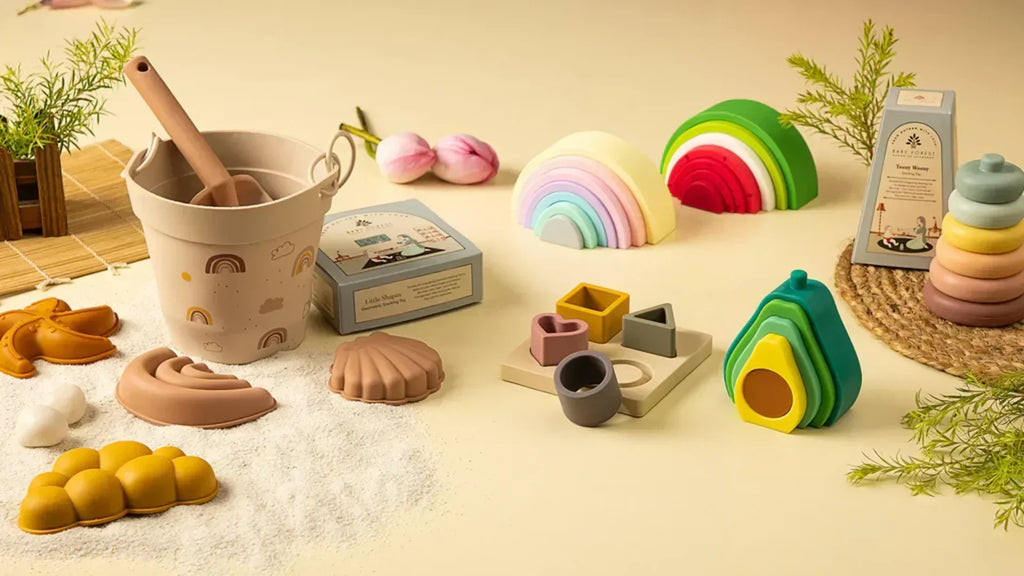
Things to Keep in Mind Before Buying Baby Toys
Choosing toys for babies is so exciting, isn’t it? But with all the options out there, it can also feel a bit overwhelming. Toys aren’t just fun; they play a key role in your baby’s development, helping with physical, cognitive, and emotional growth. But with all the excitement, you also have the responsibility to pick the right ones. So, how do you choose the best baby toys?
This toy-buying guide takes you through important considerations, ensuring that the toys you pick are safe, educational, and fun for your lil one.
What are some considerations while purchasing baby toys?

Safety Standards
Safety comes first when you’re thinking about how to buy safe toys for your baby. All toys should be tested for toxic materials, choking hazards, and other risks. Be extra cautious with baby toys that have tiny pieces, sharp edges, or parts that could come off. Even when you buy baby toys that meet safety standards, supervision is always a must!
Age-Appropriate Toys
It’s super important to choose toys based on your baby’s age. Most toys will have an age recommendation on the packaging. It’s your starting point for selecting toys that fit your baby’s stage of growth. For example, soft crochet toys are great for newborns, while stacking toys are perfect for toddlers who’ve started developing fine motor skills. This is a great way to ensure that toys are both fun and safe for your little one.
Material and Construction
Since babies love to put toys in their mouths, the material is key. Always opt for non-toxic, BPA-free toys. Wooden toys like a wooden car toy or a wooden spinning lattu are fantastic choices. They’re durable, safe, and typically free from harmful chemicals. Also, make sure the toy is well-made. You don’t want parts breaking off and creating a choking hazard.
Educational Value
Toys are an excellent tool for learning. When you buy baby toys, look for those that offer educational value. Choose toys that help your baby develop cognitive skills, problem-solving, and creativity. Simple puzzles and shape sorters, for example, are great for developing hand-eye coordination and spatial awareness. Playtime should be both fun and a stepping-stone for learning!
Stimulating Senses
Babies explore the world through their senses, so choose toys that engage sight, sound, touch, and even taste safely. Brightly coloured toys, gentle-sounding toys, textured toys, and those safe to chew on are all perfect for stimulating their senses. Crochet toys are especially great for tactile exploration, thanks to their varied textures and softness.
Versatility and Longevity
You don’t want to buy toys that your baby will outgrow in a few months. Look for toys that can grow with your child. Toys that offer new ways to play as your baby gets older are great investments. A beach munchkin bucket, for example, can be used for simple fill-and-dump play when your baby is young, but as they grow, it can be used for imaginative play and learning about quantities.
Easy to Clean
Babies love to make messes, so it’s essential to choose toys that are easy to clean. Look for options that can be wiped down easily or, even better, machine washable. This is especially important for toys your baby chews on or uses during meals or bath time. Keeping your baby’s toys clean helps prevent germs and keeps them safe and healthy.
Final thoughts
Choosing the right toys for your baby is all about balancing fun and responsibility. Keep in mind the age appropriateness, safety standards, material, construction, educational value, sensory stimulation, versatility, longevity, and ease of cleaning. By considering these factors, you can make smart choices that will benefit your baby’s growth and provide you peace of mind.
Whether it’s a wooden car toy, a crochet toy, or a beach munchkin bucket, every toy has the potential to be a great addition to your baby’s playtime. Remember, the best toys are those that engage your baby’s senses, encourage learning, and, above all, are safe and fun to play with. So, next time you’re wondering how to buy safe toys for your little one, or looking for tips on the best toys, consider these factors to ensure you’re making the best choices. Buy baby toys online with confidence and keep your baby’s development in mind as you shop!

All You Need To Know About Breastfeeding
Parenting comes with a lot of decisions to make. What is best for your baby is your own decision, but your friends and family also participate with you. Breastfeeding is a personal choice of a mom. The main concern is the healthy growth of your lil munchkin, no matter what way you choose! Understanding the benefits of breastfeeding for mom and baby can help you make an informed choice.
What Makes Breast Milk a Gold Milk?
The goodness of breast milk is unmatchable. Its magical qualities are there from the very first day. Whether it is a bond, nutrients, or prevention from disease, it is the best for the first six months! Here are some exceptional strengths of breast milk:
-
Colostrum:
Within a few hours after the birth, the first yellow milk is the special saviour. It is the richest in antibodies and bioactive proteins and strengthens immunity from the very start. You shouldn't be missing this one! This early milk highlights one of the key breastfeeding benefits for a baby. -
Lowers the Risk of SIDS and NEC:
Sudden Infant Death Syndrome (SIDS) and necrotizing enterocolitis (NEC) are at lower risk if the baby is fed breast milk. NEC explicitly affects premature babies, and the survival rate goes as low as 50% in difficult situations. So, breast milk is the best choice for those initial days. These preventive advantages are some of the many benefits of breastfeeding. -
Easy for Babies:
Babies can digest breast milk easily. Their body adapts to breast milk more naturally, whereas it might take a while for any other type of feeding. This adaptability is a significant benefit of breastfeeding for a baby. -
Long-Term Prevention:
Diseases like asthma, diabetes, allergies, bacterial infections, pneumonia, and obesity are prevented through breast milk in the generation where these diseases are so common. It's a saviour from the beginning. These long-term health benefits further emphasize the benefits of breastfeeding for a baby. -
Good for Mom:
Breastfeeding not only connects a baby to its mom but also connects the mom to her baby. It helps a mom cope with postpartum depression and even shrinks the possibility of developing severe diseases like breast cancer, ovarian cancer, heart disease, and diabetes. These are profound benefits of breastfeeding for mom and baby. -
Makes a Mom Happy:
The process is prolonged for more than four months. It promotes good hormones like oxytocin. It also helps the uterus get back to its size. Iron deficiency after giving birth is also recovered faster with the feeding of breast milk. These emotional and physical rewards showcase the benefits of breastfeeding for a mom.
What Makes Nursing a Difficult Choice?
As easy as it is to digest, a baby wants to feed more frequently, which limits the mother. She has to be around the child all the time. Here are some challenges and breastfeeding tips for new moms to help:
-
Sleep Deprivation:
New moms are constantly sleep-deprived. A baby must be fed before sleep or during the night if they are awake. Some mothers might feel exhausted and lose a sense of control over their bodies. Taking short naps and seeking help from family can be beneficial.
-
Dietary Restrictions:
A baby eats what their mom eats. If a mother is nursing a baby, she has to look after her diet. Consumption of alcohol, unhealthy junk, or high-sugar content food will not be a good choice for the Lil one. Maintaining a healthy diet is a practical breastfeeding tip for moms.
-
Frequent Feeding:
Babies demand frequent feeding, which can be challenging. Ensuring proper latch and experimenting with comfortable feeding positions are effective breastfeeding techniques to ease the process.
It's always a typical decision whether one should rely on alternatives for breastfeeding. A mom knows the best! Of course, nursing has its exceptional benefits but keeping the situation a priority is a wise choice sometimes. The benefits of breastfeeding for mom and baby are undeniable, but as long as the baby is healthy and nurtured well, your decision is valid and respected. Remember, learning and applying helpful breastfeeding tips can make this journey smoother for both you and your baby.
Breastfeeding is a personal choice, and it’s okay to seek support or alternatives when needed. Every mom’s journey is unique, and the goal is always the well-being of the baby and mother. Embrace your choices confidently and cherish these moments with your little one!

A Comprehensive Guide To Toilet Training For Your Baby
Toilet training is a challenging task for both babies and their parents. However, the process can be smooth and successful with the correct information and guidance. From the signs of readiness to the best techniques and approaches, we will provide you with expert advice on toilet training your baby.
Signs of Readiness
Before you begin toilet training your little one, it's important to ensure they are physically, cognitively, and behaviorally ready. This means looking for signs indicating your baby is ready to start potty training.
Physical signs indicate that your baby should be able to stay dry for longer periods. This shows that their bladder muscles are now strong enough to hold urine.
They may also be able to communicate their needs by pulling up their diaper or pants.
Cognitive signs of readiness include an understanding of basic concepts like wet and dry and an ability to communicate that their diaper needs to be changed.
Behaviorally, your baby may show an interest in the bathroom or want to imitate older siblings or parents using the toilet.
Toilet training can typically begin for children between the ages of 18 months to 3 years old, but it's important to note that every child is unique and may show readiness at varying times.
Pushing your baby to begin before they are ready can lead to frustration and setbacks. Instead, wait until your baby shows signs of readiness and is comfortable with the process.
Equipment and Supplies
To succeed in potty training, you'll need the right equipment and supplies.
- We recommend using a toilet training chair, a step stool, and comfortable underpants.
- You'll also need natural water-based baby wipes to keep your baby clean and fresh during the process. Our experts advise using natural baby wipes.
Techniques and Approaches
There are several potty-training methods and approaches that you can use, depending on your baby's needs and preferences.
- The no-diaper method involves slowly and gradually eliminating the use of diapers whenever at home so that your toddler signals to you when they must use the toilet.
- It will make them understand the wet feeling. The reward method involves giving your baby a small reward, like toddler toys or a piece of candy, every time they successfully use the toilet chair.
- Remember to use positive reinforcement, as this can shape your baby's motivation and confidence.
- Don't make your baby forcefully sit on the toilet too long if they are not doing poo or wee. The forceful attempts can make them think of this as a punishment.
Creating a Routine
Creating a consistent potty-training routine is key to success.
- Set a schedule for when your baby should use the toilet training seat and establish rituals like washing hands after every use.
- Positive reinforcement is also important at this stage; hence show praise and encouragement when your baby successfully uses the potty chair.
- Consistency and patience are paramount, as it can take time for your baby to get used to the routine.
- Feed your baby enough fibre and plenty of water to avoid constipation.
Troubleshooting Challenges
Toilet training can be challenging, and it's important to be prepared for setbacks.
- Common challenges include accidents, resistance, and regression. If your baby has an accident, remain calm and encourage them to try again. Do not scold them or shout at them.
- If they show resistance, take a break and try again later. Regression is also common, especially if your baby is going through a major change, like starting daycare or preschool.
- In these situations, being patient and supporting your baby is important. Remember, potty training tips are essential to stay calm and supportive, ensuring that your baby feels safe throughout the process.
Managing Expectations
Training your baby to use the toilet can take a lot of time and requires patience. It's important to have realistic expectations and be prepared to wait for progress. It's also normal to experience setbacks during the process. Your baby may take weeks or even months to fully grasp the routine. Celebrate small successes along the way, and don't forget to be gentle and supportive. When your baby is ready to transition from the training toilet to the regular toilet, it's important to make the transition as easy and comfortable as possible.
Conclusion
Though toilet training is a long and challenging process, it can be a rewarding experience for you and your little one if done with the right approach. At Baby Forest, we believe in providing the best possible care for your newborn baby. By following the potty-training tips and tricks outlined in this comprehensive guide, you'll be well on your way to successfully toilet-training your baby.
Also Read : Here Are The Best Ways to Treat Diaper Rashes: Home Remedies
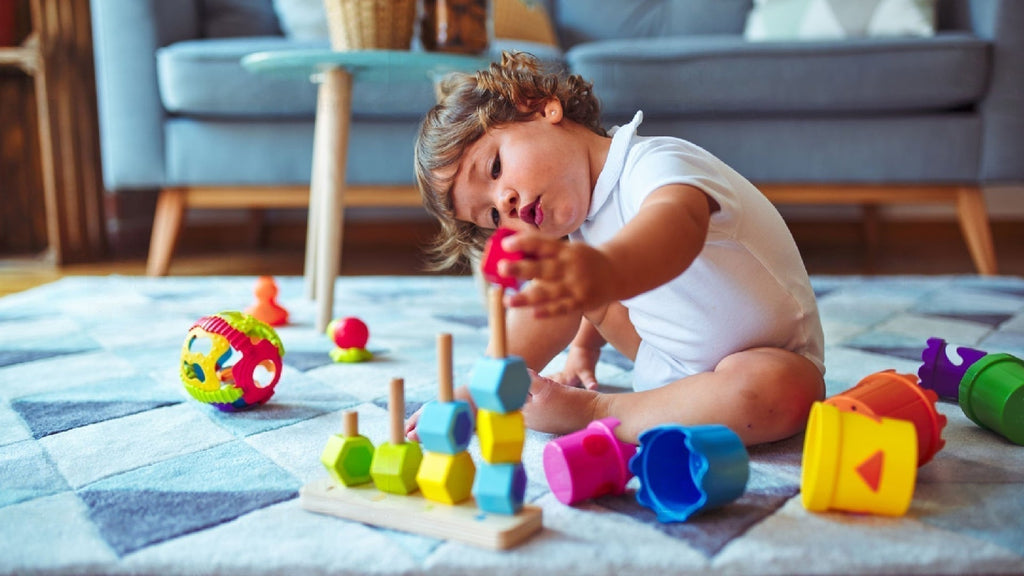
How to Introduce Your Baby to Learning?
Have you ever wondered how you instinctively know an apple is a fruit and a cucumber is a vegetable? Who categorized them for you in your mind? From simple classifications like this to self-feeding, responding to faces, and eventually talking, a baby gradually learns everything over time. It's fascinating how quickly this happens-we often don't realize that our little ones might already know so much!
Newborns are truly 'new' to everything. Their experiences shape their understanding of the world. And as parents, you open the doors to these experiences. Letting your baby feel, explore, play, and speak is key to their development. If you're wondering how to introduce your baby to learning, don't worry- it's simpler than you think.
Easy Speech Activities for Little Ones
Here are some tips to help your baby learn and grow while making parenting joyful:

Baby Sound Learning
Teaching newborns begins with sound. In the first three months, your baby is at the babbling stage. Though they don't form words yet, they react to sounds! Watch how their tiny faces light up or turn toward a sound. One of the sweetest moments? When your baby smiles, hearing your voice-it's the familiarity that makes them happy.
At this stage, baby toys with gentle sounds are a great choice. Music not only engages them but also enhances their development. It's a fun way to help newborns play and build their listening skills.
Baby Language Learning
Words are magical for babies. While they might not yet understand the emotions behind words, they learn their importance through your tone and actions. How to teach a newborn language? Start simple. Say "Good morning" to signify it's time to wake up and start the day. Say "Good night" to teach them that it's time to rest.
These little affirmations create structure and introduce your baby to language and routine. Saying "Goodbye" when leaving reinforces the concept of departures and arrivals. These small, consistent actions lay the foundation for their language development.
Baby Visual Learning
Babies are visual learners, but it takes time for their cognitive processes to develop. Unlike adults who can imagine things instantly, babies need concrete references. This is where visual aids come in.
Start with categories like animals, fruits, daily objects, vehicles, or body parts. When you show them a picture and say the word, they begin associating the two. Over time, this strengthens their ability to form complete sentences. Incorporating newborn brain development activities like picture books or flashcards can make this process even more engaging for your little one.
Baby Playtime Learning: Dexterity and Mobility
Playtime is vital for learning dexterity and mobility. Allow your baby to move things around, manipulate toys, and explore their surroundings. Toys that require hand movements, like stacking blocks, are excellent for enhancing hand-eye coordination.
Introduce toys that also teach shapes and colours. These are great activities for 1-year-olds who are curious and eager to explore. For example, FDA-approved, child-friendly stacking toys ensure safety while boosting creativity and motor skills.
As your child starts to crawl and walk, let them roam and explore freely. Yes, they might stumble or fall, but that's all part of the process. Give them gentle affirmations like "You're fine!" to reassure them and build their confidence. If you're wondering how to help a newborn play, remember to be a part of their explorations and encourage their little adventures.
Baby Skill Development: Portray Play
Do you remember those imaginary games from your childhood, like running a barber shop or pretending to teach dolls? These games play a crucial role in a child's brain development. Through pretend play, your child learns about relationships, social cues, and communication.
Parenting tips for new parents often emphasize play as a cornerstone of learning. You don't have to create rigid teaching moments. Instead, simply talk to your baby, play with them, and listen to what they say. These interactions will naturally evolve into meaningful learning experiences over time.
Help Your Baby Sleep and Learn
Sleep is crucial for newborn brain development. If you're wondering how to sleep-train a newborn, start by creating a consistent bedtime routine. This might include a warm bath, gentle sounds, or quiet playtime before bed. A well-rested baby is more active and curious, making it easier to introduce new learning activities.
Also Read: Types of Toys for Children by Age and Developmental Stage
Final Thoughts
There are no complicated rules when it comes to helping your baby learn. Teaching newborns is about creating opportunities for exploration, providing gentle guidance, and being present. From introducing newborn brain development activities to engaging in fun activities for 1-year-olds, everything you do contributes to their growth.
So, take a deep breath and enjoy this journey of discovery with your little one. Every smile, babble, and playful moment is a step toward a bright and curious future!

Does Your Baby Need Face Cream? Here's What You Should Know
As a new parent, it's totally normal to wonder about the best ways to care for your baby's delicate skin. You've probably seen a ton of products out there marketed as essentials, but when it comes to baby face cream, is it really necessary? Should you be adding it to your baby care routine? Let's break it down and help you make an informed decision.
Understanding Your Baby's Skin
Babies are born with soft, smooth, sensitive, and still-developing skin. Unlike adults, their skin is thinner, more porous, and more prone to irritation. Plus, it cannot protect itself from environmental stressors like the sun, wind, or pollution. That's why many parents turn to baby face cream that can help shield and hydrate their little one's skin.
However, while their skin might need some extra care, not all products are the right fit. So, let's take a closer look at whether a baby face cream is necessary for your baby.
Does Your Baby Need Face Cream?
In most cases, your baby's skin might not need baby face cream. Newborns and infants usually don't require a complicated skincare routine-just a gentle bath and a mild moisturizer, like baby lotion, will do the trick. Their skin typically does a great job if it's not exposed to harsh conditions.
That said, baby face creams aren't a bad idea either. Sometimes, your little one's skin might need a little extra TLC. If they have dry patches, redness, or irritation, a baby face cream could be just what they need to feel more comfortable. But don't jump to conclusions just yet-let's dive into how you can figure out if your baby really needs one.
Signs Your Baby May Need a Face Cream
There are a few tell-tale signs that your baby might benefit from baby face cream. Here are some of the most common:

-
Dry Skin:
If your baby's skin is feeling rough or flaky, especially on the face, it may be a sign they need some extra moisture. -
Chapped Skin:
Exposure to wind, cold air, or frequent drooling can cause your baby's skin to become chapped, particularly around the cheeks and chin. -
Eczema:
Babies with eczema or other skin conditions may have inflamed or itchy skin, making a soothing baby face cream an important part of their routine. -
Redness or Irritation:
Sometimes, certain environmental factors or even a diaper rash can cause irritation on the face. A gentle, calming cream could help.
If you notice any of these signs, a baby face cream could be helpful in providing extra hydration and soothing relief. But make sure to consult your pediatrician before trying any new products.
What to Look for in a Baby Face Cream
Choosing the right baby face cream can be tricky with all the options available. To make sure you're picking a safe and effective product, here are some key things to look for:
-
Gentle Ingredients:
Look for creams that are free of harsh chemicals, fragrances, or dyes. Natural and organic ingredients like shea butter, aloe vera, and chamomile is great for soothing sensitive skin. -
Hypoallergenic:
Babies can have sensitive skin that's prone to reactions. Opt for a hypoallergenic cream to reduce the risk of irritation. -
Moisturizing:
Since your baby's skin needs plenty of hydration, choose a baby face cream that has moisturizing ingredients such as glycerin, jojoba oil, or coconut oil. -
Non-Comedogenic:
Some creams can clog pores. For babies, look for creams that are non-comedogenic to avoid breakouts or rashes. -
Derma Safe:
Products that are derma safe are often safer and more reliable for your baby's skin.
By paying attention to these qualities, you can choose a baby face cream that will keep your baby's skin soft and hydrated without risking any adverse reactions.
How to Use Baby Face Cream Safely
If you've decided that a baby face cream is right for your little one, it's essential to apply it safely. Here are some tips to keep in mind:
-
Start with Clean Skin:
Always clean your baby's face before applying any cream. Use a gentle, baby-friendly cleanser to remove dirt or impurities. -
Test First:
Before applying a new product, do a patch test on a small area of skin to check for any allergic reactions. -
Use a Small Amount:
Babies don't need a lot of products. A tiny dab of baby face cream is enough to cover their face. -
Gently Massage:
Apply the cream in gentle circular motions to help it absorb into the skin.
By following these simple steps, you'll ensure that you're using baby face cream safely and effectively.
Benefits of Using a Face Cream for Your Baby
Using a baby face cream can offer a range of benefits for your baby's skin, including:
-
Moisture Retention:
Baby skin is more prone to drying out, especially in harsh weather conditions. A nourishing cream locks in moisture and helps prevent dryness. -
Protection from the Elements:
Whether it's cold air or direct sunlight, a good face cream provides an extra layer of protection against environmental stressors. -
Soothing Relief:
For babies with skin irritations, rashes, or eczema, a baby face cream can help soothe the skin and reduce discomfort.
With the right product, a baby face cream can keep your little one's skin soft, protected, and comfortable all year round.
Conclusion
So, does your baby need baby face cream? It really comes down to your baby's skin and any specific concerns you might have. For a lot of babies, a gentle moisturizer does the job just fine. But if your little one has dry patches, redness, or other skin issues, a baby face cream could be exactly what they need. Just make sure to pick one with safe, gentle ingredients, and always check with your pediatrician if you're unsure. At the end of the day, you're doing your best to keep your baby happy, healthy, and comfortable!

6 Ways to Boost Your Child's Imagination

What Are Baby Growth Spurts? Everything Parents Need to Know
Becoming a parent is an amazing journey, but let's be honest-it comes with its fair share of surprises! One moment, your baby is all smiles and coos, and the next, they're fussier, hungrier, and growing like a little sprout overnight. This is what we call a growth spurt, and if you're wondering what's going on, you're definitely not alone. Let's talk about what growth spurts are and everything you need to know to get through them.
What Are Baby Growth Spurts?
A growth spurt in babies is a short period of rapid growth where your little one's body is busy getting taller, gaining weight, and sometimes even learning new skills. These spurts can happen suddenly, leaving you wondering what's going on-it's just your baby's way of growing and developing.
Growth spurts can feel challenging at times. Your baby might feed more often, have disrupted sleep, or seem a bit fussier than usual. But don't worry, this phase is completely normal and will pass soon, leaving you with a happy and thriving little one.
When Do Growth Spurts Happen?
Growth spurt in babies can be a bit predictable. They tend to happen during the first year, and there are some common phases when they're likely to occur:
- 1 to 3 weeks
- 6 weeks
- 3 months
- 6 months
- 9 months
Of course, every baby is different, so these timings can shift a little. Some might have a growth spurt earlier or later than expected, and that's fine. These spurts usually last a few days to a week. Before you know it, your baby will be back to their usual self-just a little bigger and more curious about everything around them!
Signs Your Baby Is Going Through a Growth Spurt
Wondering if your baby's going through a growth spurt? Here are some signs to look out for:
Increased Hunger:
Your baby might suddenly seem like they can't get enough milk. Whether you're breastfeeding or bottle-feeding, you may notice them feeding more often or for longer stretches.
Changes in Sleep Patterns:
Growth spurts can make your baby sleep more than usual to support all that growth. On the flip side, they might wake up more frequently for extra feed.
Fussiness:
When babies are going through a growth spurt, they can get extra cranky. They're hungry and tired, and their bodies are working hard, which can make them a bit irritable.
Clinginess:
You might find your baby wanting to be held more often. They're looking for comfort while going through this big developmental leap.
Noticeable Growth:
After the growth spurt, you might notice their clothes feeling a little snugger, or their head seems a bit bigger proof that they've been growing!
What Causes Baby Growth Spurts?
The exact triggers for growth spurt in babies aren't fully understood, but they're just a natural part of growing up. During these times, your baby's body and brain are growing at a rapid pace, with a mix of genetics, nutrition, and their surroundings all playing a role.
Physical Growth:
Their bones, muscles, and organs develop super quickly during these spurts.
Brain Development:
These growth spurts often come hand-in-hand with mental leaps, helping your baby pick up new skills and abilities.
Nutritional Needs:
As all this growing happens, babies need extra calories to fuel the changes, which is why they might seem hungrier than usual.
How to Handle Baby Growth Spurts?
Growth spurt in babies can feel intense, but with a little prep and patience, you can manage them. Here's how you can help your baby through it:
Follow Their Lead:
Let your baby eat and sleep as much as they need. Their body knows exactly what it's doing during a growth spurt.
Stay Hydrated:
If you're breastfeeding, be sure to drink plenty of water to keep your milk supply flowing strong.
Offer Comfort:
When your baby's fussy, hold them close and offer some cuddles. Sometimes, they just need that extra bit of reassurance.
Don't Skip Meals:
If your baby is eating solids, make sure their meals are balanced and full of nutrients to fuel all that growing.
Be Patient:
Remember, this phase is temporary! Your baby will settle back into their usual routine soon enough.
Myths About Baby Growth Spurts
There are a lot of myths out there about growth spurt in babies, so let's clear a few up:
Myth 1: Growth spurts only happen in the first year.
Fact: Actually, growth spurts can happen throughout childhood, especially during those teenage years.
Myth 2: Fussiness always means a growth spurt.
Fact: While fussiness is common during a growth spurt, it could also be due to teething, illness, or just a bad day.
Myth 3: Babies need supplements during growth spurts.
Fact: Most of the time, a well-balanced diet or breast milk provides everything your baby needs during a growth spurt.
When to Be Concerned?
While growth spurt in babies is totally normal, there are a few times when it's a good idea to check in with a doctor:
- If your baby isn't gaining weight consistently.
- If they're feeling unusually lethargic or extra fussy for a longer period.
- If you notice other worrying symptoms, like a fever or rash.
Trust your instincts. If something doesn't feel right, it's always okay to reach out to a professional for advice. Better safe than sorry!
Conclusion
Growth spurt in babies can be challenging, but they're also a sign that your little one is growing and thriving. With a bit of understanding and a lot of love, you can help them through these phases with ease. Remember, every baby is unique, and their growth journey will unfold at its own pace. Embrace the changes, cherish the milestones, and know that you're doing an amazing job as a parent.
Related Read - Importance of Baby Growth Chart for a Parent
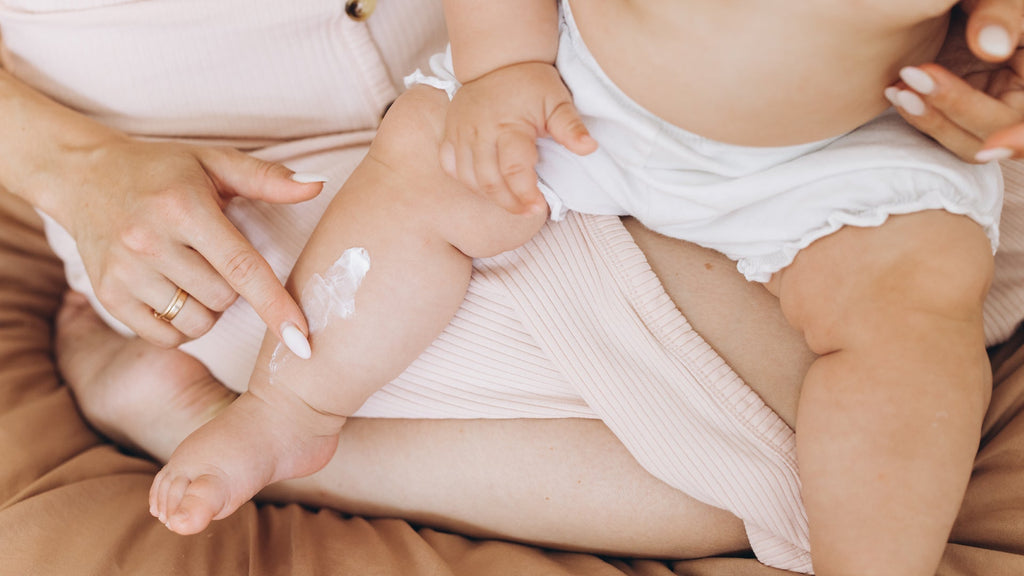
Winter Dry Skin in Babies: Why Lotion is a Must-Have This...
Winter brings a chill in the air, cosy blankets, and festive cheers. But for babies, it also brings dry, flaky skin that can be uncomfortable and even painful. As parents, you want your baby to feel soft, smooth, and happy in their delicate skin. That's where baby lotion comes to the rescue, especially organic ones that nurture and protect without any harsh chemicals.
Ingredients like shea butter, coconut oil, and almond oil work wonders for hydration. For example, the Moh Malai Baby Body Lotion use these natural elements to deeply moisturize and nourish, keeping your baby's skin supple and glowing even in winter. Shea butter locks in moisture, coconut oil softens, and almond oil ensures smoothness-all while being gentle and safe.
With the right baby lotion, winter can be all about cuddles and comfort for your little one!
Why Baby Skin Needs Extra Care in Winter
Baby skin is so much thinner and more delicate than ours, making it prone to losing moisture quickly-especially during winter. Dry air outside and heaters inside can leave their skin feeling parched, sensitive, and even itchy.
In cold weather, natural oils in the skin disappear faster, often leading to redness, irritation, or even eczema. Since babies can't tell us they're uncomfortable, you might notice extra scratching, fussiness, or dry patches. That's why using a gentle, organic baby lotion regularly is a game-changer. It not only locks in moisture but also protects their skin barrier and soothes irritation, keeping your little one comfy and happy all winter long!
Benefits of Using Lotion for Winter Dry Skin
Using baby lotion in winter isn't just about adding a soft touch; it's about protecting your baby's health. Here are some benefits:
-
Hydration:
A good baby lotion replenishes lost moisture, keeping the skin soft and supple.
-
Barrier Protection:
Organic lotions often contain natural oils like coconut, almond, or shea butter, which form a protective barrier against harsh elements.
-
Healing Properties:
Many organic baby lotions have ingredients like aloe vera or calendula, which soothe redness and heal minor irritations.
-
Prevents Cracking:
Consistent use prevents severe dryness that can lead to painful cracks or bleeding.
-
Comfort:
Babies with well-moisturized skin are less likely to scratch and fidget, leading to better sleep and happier moods.
Choosing the Right Baby Lotion for Winter
Not all lotions are created equal. When choosing a baby lotion for winter, here are a few things to keep in mind:
-
Go Organic:
Organic baby lotion is free from harmful chemicals, synthetic fragrances, and dyes. It's gentle and safe for sensitive baby skin. -
Look for Moisturizing Ingredients:
Natural ingredients like shea butter, cocoa butter, and almond oil are excellent for deep hydration. -
Hypoallergenic Options:
If your baby has sensitive skin, choose a lotion labelled hypoallergenic to reduce the risk of irritation. -
Fragrance-Free or Mildly Scented:
Strong fragrances can irritate delicate skin. Opt for unscented or naturally scented products. -
Test First:
Always do a patch test on a small area of your baby's skin to ensure there's no allergic reaction.
Tips for Applying Lotion Effectively
Applying baby lotion isn't just about slathering it on. There's a technique to make it work better:
-
Apply After Bath Time:
Moisturize your baby immediately after a bath while their skin is still damp. This helps lock in the moisture. -
Use Gentle Motions:
Use light, circular motions to apply the lotion. Avoid rough rubbing. -
Don't Forget the Creases:
Pay attention to areas like behind the knees, elbows, and neck folds where dryness often hides. -
Keep It Handy:
Reapply throughout the day, especially on exposed areas like the face and hands. -
Warm the Lotion:
Rub the lotion between your palms before applying it to avoid shocking your baby with cold cream.
Additional Winter Skin Care Tips for Babies
While baby lotion is the hero of winter skin care, a holistic approach works best. Here are some additional tips:

-
Humidifier:
Place a humidifier in your baby's room to add moisture to the air. -
Avoid Over-Bathing:
Frequent baths can strip natural oils. Limit baths to every other day and use lukewarm water. -
Dress Wisely:
Use soft, breathable fabrics like cotton to prevent irritation. Avoid wool directly on the skin. -
Stay Hydrated:
If your baby is old enough, ensure they're drinking enough water to keep their skin hydrated from the inside out. - Protect Against the Elements:
Use a weather-appropriate barrier cream or lotion before taking your baby outdoors.
Common Questions Parents Have About Winter Skin Care
-
How often should I apply lotion to my baby in winter?
Aim to apply baby lotion at least twice daily-right after baths to lock in moisture and before bedtime for overnight hydration. If you notice dry patches, feel free to reapply as needed during the day.
-
Can I use regular lotion instead of baby lotion?
It's best not to. Regular lotions often have harsher ingredients that might irritate your baby's sensitive skin. Stick to gentle, specially formulated baby lotions to keep their skin safe and soft.
-
What if my baby's skin is still dry despite using lotion?
If your little one's skin stays dry, it's worth checking in with your paediatrician. They may suggest a richer cream or evaluate for conditions like eczema that might need extra care.
-
Are organic lotions better?
Yes! Organic baby lotions are free from harmful chemicals, making them a safer option. Plus, the natural ingredients deeply nourish and protect your baby's delicate skin.
Conclusion
Winter can be tough, but with a little extra love and the right care, your baby's skin can stay soft, smooth, and healthy. This season, organic baby lotion is a must-have-it keeps your little one's skin hydrated, protected, and comfy no matter how chilly it gets. Pair it with simple skincare habits like short baths and a cosy humidifier, and you'll be mastering winter parenting in no time. After all, happy, healthy skin means a happy baby-and isn't that the best gift of all?

5 Winter Foods That You Should Include In Your Lil One's ...
Winter can be a tricky season, can't it? Especially for new parents juggling a thousand things while trying to keep their little one's cosy and healthy. You're probably wondering how to keep those sniffles at bay and boost your child's immunity. Well, let me tell you, a good diet packed with the right nutrients can work wonders! By adding a few carefully chosen winter foods for toddlers and winter superfoods for kids, you can help your baby stay strong and healthy through the season. Here are a few simple, nourishing options for your child's winter diet for kids!
5 Gentle Foods to Warm Your Winter Naturally

1. Badam Halwa (Almond Pudding):
Almonds are your baby's best friend. As soon as your lil one turns one plus, start feeding them almonds halwa in winter. A spoonful quantity is all you need to provide them with rich protein and strengthen their bones. If your child is over a year old, a small serving of this warm dessert can give them the energy they need to stay active and warm during those chilly days. And here's another tip: almond oil isn't just for eating-it's amazing for massages, too!
Along with their diet, give them a massage with Baby Forest Badami Sneh organic cold-pressed almond oil to boost their growth and immunity. A gentle almond oil massage can do wonders for your baby's skin, keeping it soft and hydrated through the dry winter months. It's a win-win for both you and your baby!
2. Turmeric Milk (Haldi Doodh):
This one is a saviour from cough and cold. It requires almost no time, and mammas are free from doing something extra. Giving your baby turmeric milk is the most accessible because all you need to do is add a pinch of haldi while you feed milk from your spice box. It boosts the baby's immunity and antioxidants do their magic whenever needed.
Incorporating haldi milk for babies can be a simple yet effective way to boost their immunity. Just a warm cup of milk with a pinch of turmeric can work wonders. It helps boost their immunity, keeping those pesky colds and coughs at bay. Plus, it's so comforting-perfect for those chilly winter nights. It not only keeps your little ones healthy but also warms them up from the inside. Think of it as a hug in a cup for your baby!
3. Lentil and Vegetable Soup:
If your baby is weaning, dal soup is one of the most nutrient-rich foods, full of protein. A hearty lentil and vegetable soup, for instance, is loaded with proteins, vitamins, and minerals that are essential for their growth and development.
The best part? Its smooth texture makes it super easy for babies to slurp down happily! Plus, the warmth of the soup is just what they need to stay cosy on chilly days. Adding such soups to your child's winter food chart for kids not only makes mealtime nutritious but also helps ensure they're getting a balanced diet. It's a simple and wholesome way to keep their health on track all through winter.
4. Sweet Potatoes:
Sweet potatoes are a winter favourite, and for good reason! They're packed with beta-carotene, vitamin A, and fibre, making them a nutrient-rich addition to your little one's winter food for kids. Their natural sweetness and soft, creamy texture make them a hit with most children-it's like nature's dessert in a vegetable.
You have so many options when it comes to serving sweet potatoes. You can mash them, roast them, or blend them into a smooth puree. However, when you prepare them, they're sure to be a comforting treat. What's more, the antioxidants in sweet potatoes help detoxify the body, while their warmth-producing properties make them perfect for keeping your child snug during the chilly season. They're the ultimate winter superfood for kids!
5. Jaggery Syrup with Nuts:
The right amount of jaggery, not too little and not too much, is good in winter for babies. Its natural sweetness makes it a healthy alternative to sugar, and it's packed with essential minerals like iron. For younger babies, whole nuts might be a bit tough to handle, but you can easily mix powdered nuts into a warm jaggery syrup.
This combination isn't just delicious; it's a natural remedy for coughs and colds while helping produce natural heat in the body. It's a comforting treat that also supports their immunity during the cold season. Just be sure to introduce jaggery after consulting your paediatrician, especially if your baby is under one year old. It's a wonderful addition to your child's winter food chart for kids!
Conclusion
By adding these wholesome, comforting foods to your child's diet, you're doing more than just preparing delicious meals-you're giving their immunity a much-needed boost to tackle the winter chill. Each of these winter superfoods for kids brings its own set of benefits, ensuring your little one stays healthy, warm, and happy.
Remember, every baby is unique, and their little bodies might respond differently to new foods. Start slow, observe how they react, and always check with your paediatrician if you're unsure. Parenting can be a rollercoaster, but with the right nutrition and a little bit of love, you've got this.

How to Soothe Your Newborn's Hiccups
Welcoming a newborn into the world is such a joyful yet sometimes overwhelming experience. As parents, we all want to do everything we can to ensure our little one's comfort and well-being. One thing that might leave you scratching your head, though, is those hiccups in newborn babies.
At first, they might seem alarming, but don't worry-hiccups are usually harmless. Still, they can be frustrating for you and your baby. In this article, we will explore why babies get hiccups, how to soothe them, and what to avoid, so you can confidently handle this common situation.
Why Do Newborns Get Hiccups?
Hiccups in newborn babies are pretty common, so there's no need to panic when it happens. But why do they occur? Simply put, hiccups happen when the diaphragm-the muscle just below the lungs-contracts involuntarily. This sudden contraction causes the classic "hic" sound. Babies are often triggered by swallowing air while feeding, having a full stomach, or even a slight temperature change. These little hiccups are totally normal and part of your baby's development. While they can feel unsettling, they're usually nothing to worry about.
Are Hiccups Harmful to Babies?
Many parents wonder if hiccups in newborn babies are harmful, and the short answer is no-they're not. Hiccups don't usually cause pain or distress for most babies. In fact, they often go away on their own after just a few minutes. Your baby's body is still adjusting to the world outside the womb, and hiccups are just part of that process. While they can sometimes be a little annoying, they're generally a temporary phase. However, if the hiccups bother your baby a lot or last for an unusually long time, it's always a good idea to check in with your pediatrician.
Tips to Soothe Your Baby's Hiccups
As a parent, you'll want to soothe your baby as quickly as possible when those pesky hiccups in newborn strike. Here are some simple and effective tips to help manage them:

-
Try Feeding Your Baby:
Sometimes, the act of sucking can help relax the diaphragm and stop the hiccups. Offer your baby a small amount of milk or water (depending on their age) and let them feed slowly. This can often calm the spasms. -
Burp Your Baby:
If your baby has hiccups, trapped air in their stomach might be the culprit. After feeding, gently burp them to release any trapped air. This can often prevent or stop the hiccups altogether. -
Change Positions:
If your baby's hiccups persist, try changing their position. Hold them upright for a while after feeding to let gravity help. Alternatively, rocking them gently or placing them in a different position may help ease the discomfort. -
Use a Pacifier:
Offering a pacifier can sometimes provide relief from hiccups in newborns. The sucking motion can help relax the diaphragm and stop the hiccups in their tracks.
-
Give Your Baby a Warm Bath:
A warm bath can help your baby relax and may provide some relief from hiccups. The warmth can soothe their muscles and help them feel more comfortable.
These tips can help you ease your baby's hiccups quickly so you both can get back to enjoying some peaceful moments together.
What to Avoid When Dealing with Baby Hiccups
While there are plenty of ways to soothe hiccups in newborn babies, there are also a few things you'll want to avoid. First, never try to startle your baby to stop their hiccups. It might seem like a quick fix, but it can actually upset them, and it won't solve the problem. Second, steer clear of giving your baby water or any solid food if they're too young.
Babies under six months should only have breast milk or formula, as other liquids can mess with their digestive system. And lastly, avoid overfeeding your baby. Sometimes, hiccups in newborn babies are caused by overeating, so smaller, more frequent feedings are usually the way to go. Keep these tips in mind, and you'll help your baby feel more comfortable!
Preventing Hiccups in the Future
While you can't always prevent hiccups in newborn babies from happening, there are a few simple strategies to help reduce the chances of them occurring:
-
Feed Your Baby Slowly:
Let your baby take their time during feedings. If they're feeding too quickly, they might swallow air, which can lead to hiccups. Taking small breaks during the feeding can help them pace themselves. -
Burp Frequently:
Burp your baby every few minutes during the feeding. This helps release any air trapped in their stomach, which can cut down on the likelihood of hiccups. -
Keep Baby Upright After Feedings:
After feeding, try holding your baby upright for at least 20 minutes. This can aid digestion and help prevent hiccups. -
Avoid Overfeeding:
It's tempting to let your baby feed as long as they want, but overfeeding can increase the chances of hiccups. Stick to their feeding schedule and avoid pushing them to finish more than they need.
These simple tips can help make hiccups in newborn babies less frequent, giving you and your baby a little more peace of mind.
When to Consult a Doctor?
In most cases, hiccups in newborn babies aren't something to worry about. However, if your baby's hiccups seem to last a long time or cause them discomfort, it's a good idea to reach out to your pediatrician. If the hiccups go on for more than an hour or happen frequently throughout the day, it could be a sign of something like acid reflux or another digestive issue. Always trust your instincts-if something doesn't feel right, don't hesitate to call your baby's doctor. It's better to be safe and get some peace of mind.
Conclusion
Dealing with hiccups in newborn babies can definitely be a little frustrating, especially when you're already juggling the many challenges of new parenthood. But remember, hiccups are totally common and usually harmless. In most cases, they'll go away on their own without you needing to do much. By following a few simple tips-like feeding slowly, burping your baby, and trying different positions-you can help soothe your little one and make those hiccups a bit easier to handle. And of course, if you're ever worried, don't hesitate to reach out to your pediatrician. Parenthood is all about learning as you go, and you're doing great!

What is a Breech Baby? Understanding the Different Breech...
Welcoming a new life into the world is such an incredible journey, isn't it? But let's be honest—it's also full of surprises and challenges that no one really prepares you for. One of those surprises might be finding out that your baby is in a breech position. If you've just learned this, it's completely normal to feel a mix of emotions—maybe some confusion, worry, or even fear. Take a deep breath—you've got this.
In this article, we'll walk you through what it means to have a breech baby, why it happens, and the options available to you. Knowledge is power, and we're here to help you feel confident and informed every step of the way.
What is a Breech Baby?
So, what exactly is a breech baby? It just means your little one is positioned feet or bottom first in the womb instead of the usual head-down position. Normally, as your baby grows and gets ready for birth, they'll flip head-down to make delivery a bit smoother. But sometimes—about 3-4% of the time—babies decide to stay in a breech position as labor approaches.
Here's the thing: if your baby is breech, it's not your fault. It's just one of those unpredictable things that can happen during pregnancy. The good news? With the right care and support, many parents navigate this situation beautifully. You're not alone in this!
Understanding the Different Breech Positions
Not all breech babies are positioned the same way, and understanding the different types can help you make sense of your baby's situation. Here's a quick rundown:
Frank Breech:
This is the most common type of breech position. Your baby's bottom is down, with their legs pointing straight up and their feet near their head—kind of like a V shape.
Complete Breech:
In this position, your baby's bottom is down, but their knees are bent, and their feet are tucked close to their bottom—imagine a cozy sitting position.
Footling Breech:
Here, one or both of your baby's feet are positioned to come out first during delivery. This position is less common but can present specific challenges.
Kneeling Breech:
This rare position involves your baby being on their knees, with one or both knees positioned to come out first.
Each type of breech baby comes with its own considerations, but don't worry—your healthcare provider will guide you through the best approach based on your baby's position.
What Causes a Breech Baby?
The exact reasons for having a breech baby aren't always clear, but there are some factors that can make it more likely:
-
Premature Birth:
If your baby is born early, it might not have had enough time to turn its head down. -
Multiple Pregnancies:
Carrying twins or more can make space tight, leaving less room for each baby to move into the head-down position. -
Uterine Shape or Abnormalities:
If your uterus has an unusual shape or certain conditions, it might limit your baby's ability to move around. -
Excess or Too Little Amniotic Fluid:
Too much fluid can give the baby too much room to move, while too little can make movement more difficult. -
Placenta Placement:
A low-lying placenta can sometimes block the baby's ability to turn.
That said, many breech babies happen without any clear explanation, so if this is your situation, know that you're not alone, and it's not something you caused!
How Is a Breech Baby Diagnosed?
Your doctor will typically check your baby's position during your prenatal visits in the third trimester. They might feel your abdomen or do an ultrasound to see if your baby is head-down or in a breech baby position. They could also use other methods, like fetal heart monitoring or a physical exam, to help determine your baby's position.
If it turns out your baby is a breech baby, don't worry—your doctor will walk you through the next steps and discuss your options.
What Are the Options If Your Baby Is Breech?
So, what can you do if your baby is in a breech baby position? The good news is there are a few options:
-
External Cephalic Version (ECV):
This is a procedure where your doctor will try to manually turn your baby into the head-down position by applying gentle pressure on your abdomen. It's usually done around 37 weeks and has a pretty good success rate. However, it's not right for everyone. -
Exercises and Techniques:
Some parents try natural methods like pelvic tilts, yoga positions, or swimming to encourage their baby to turn. These can be safe, but it's always a good idea to check with your doctor first. -
Delivery Planning:
If your baby stays breech, your doctor might recommend a planned cesarean delivery. In some cases, a vaginal breech delivery can be an option, but it requires careful assessment and a lot of expertise.
Every situation is different, so the best approach will depend on your health, your baby's position, and other factors. Just remember, you can trust your medical team to guide you through this and help you make the best decision.
Emotional Support for Parents
Learning that your baby is a breech baby can definitely feel overwhelming. It's totally normal to feel anxious or uncertain about what's ahead. But here's the thing: you're not alone. Many parents have faced this and gone on to have healthy babies and positive birth experiences.
Here are some tips to help you cope:
-
Ask Questions:
The more you understand, the more confident you'll feel. Don't be afraid to ask your doctor anything that's on your mind—no question is too small. -
Connect with Others:
Look for support groups or online communities where you can talk to other parents who've been through similar experiences. It can really help to hear their stories and advice. -
Take Care of Yourself:
Make sure to practice relaxation techniques, stay active (as advised), and lean on your loved ones for support. Taking care of your mind and body is important during this time.
Remember, your feelings are totally valid. It's okay to seek emotional support when you need it—this journey is unique for everyone, and there's no one right way to feel.
Conclusion
Having a breech baby might not be what you expected, but it doesn't mean you can't still have a beautiful birth experience. The more you understand what a breech baby is, learn about the different breech positions, and explore your options, the more empowered you'll feel to make the best decisions for both you and your baby. With the right care, support, and a bit of patience, you've totally got this. Remember, parenting is a journey full of twists and turns—and this is just the beginning of your amazing story.
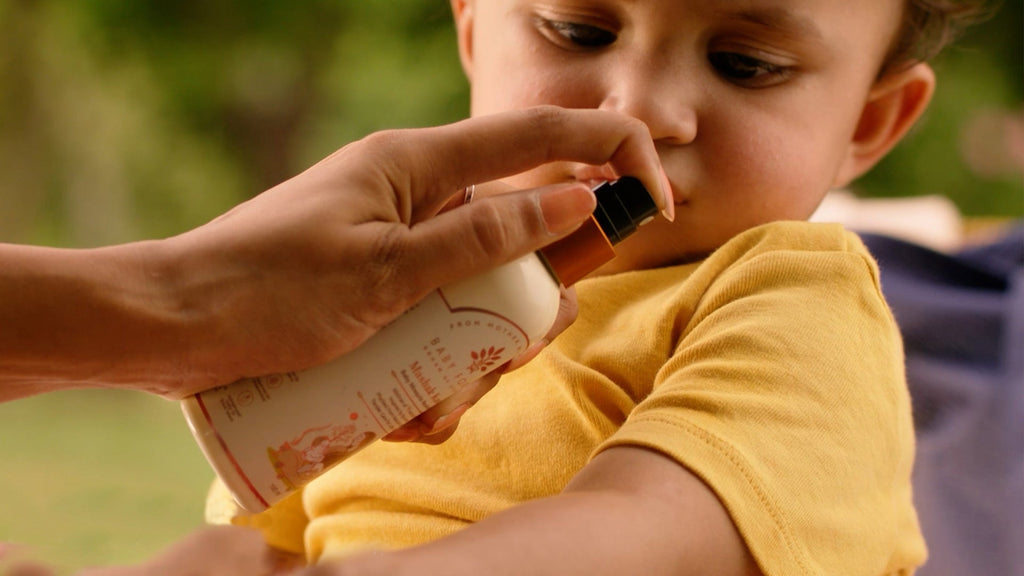
How to Protect Your Baby from Mosquito Bites
As a parent, your baby's safety and comfort are always top priorities. One of the biggest worries for moms, especially with newborns and young babies, is how to protect them from pesky mosquitoes and other insects. These tiny intruders don't just cause itchy bites; they can also pose health risks to your little one.
Unlike other challenges, like avoiding cold weather or harsh winds, mosquitoes seem to find their way everywhere-indoors and outdoors alike. It can feel overwhelming, but with the right strategies and tips, you can keep these pests away and give your baby a safe, cosy environment to thrive.
Why Mosquitoes Are a Bigger Problem for Babies
Mosquitoes are more than just a nuisance. They can carry diseases like dengue, malaria, and Zika virus. Babies are particularly vulnerable because their immune systems are still developing. Plus, their skin is more sensitive, making them prone to irritation and allergic reactions from bites.
Unlike adults, babies can't swat away mosquitoes or tell us when they're uncomfortable. That's why it's so important to be proactive in preventing mosquito bites for babies. Awareness is the first step to prevention.
Natural Mosquito Repellent Methods
If you're looking for organic and chemical-free ways to prevent mosquito bites for babies, nature has got you covered! Here are some tried-and-true methods:
- Essential Oils: Oils like citronella, eucalyptus, and lavender are excellent natural repellents. Mix a few drops with a carrier oil like coconut and apply to areas near your baby (not directly on their skin).
- Bhustarah (Lemongrass Oil): Known for its strong mosquito-repelling properties, lemongrass oil can be a great addition to your natural defence strategy.
- Cedarwood Oil: This oil is not only a mosquito repellent but also has a calming effect, making it ideal for babies.
- Lavender Oil: Besides repelling mosquitoes, lavender oil soothes and relaxes babies, ensuring a peaceful environment.
- Neem Leaves: Burning dried neem leaves can repel mosquitoes naturally. Ensure the smoke doesn't reach your baby directly.
- Garlic and Lemon Spray: A homemade mixture of garlic and lemon boiled in water can be sprayed around windows and doors. It's a safe and effective barrier.
- Herbal Mosquito Repellent Patches: Look for patches made from natural ingredients. These can be placed on clothes, strollers, or cribs.
Natural solutions are great because they're gentle and safe. This is why Mashak Kawach Baby Mosquito Repellant Spray is a natural and safe solution for babies. It contains ingredients like lemongrass, cedarwood, lavender, citronella, eucalyptus etc. known for their strong mosquito-repelling properties.
Physical Barriers for Extra Protection
Sometimes the simplest solutions are the best. Physical barriers are a foolproof way to protect newborns from mosquitoes without relying on sprays or lotions.
- Mosquito Nets: Use fine mesh mosquito nets over cribs, bassinets, and strollers. This is a classic method and highly effective.
- Clothing: Dress your baby in lightweight, long-sleeved tops and pants. Opt for breathable fabrics like cotton to keep them comfortable while covered.
- Window Screens: Ensure all windows in your home are fitted with tight screens to keep mosquitoes out.
These barriers work wonders in creating a physical shield between your little one and those pesky mosquitoes.
Home Environment Control
Your home is your sanctuary, and you can make it mosquito-free with a few smart adjustments:
- Eliminate Standing Water: Mosquitoes breed in stagnant water. Check flowerpots, drains, and even pet bowls regularly.
- Use Fans: Mosquitoes are weak fliers. Placing a fan near your baby's crib can keep them at bay.
- Plant Mosquito-Repelling Herbs: Basil, lemongrass, and marigolds are natural repellents that can be grown indoors or in your garden.
- Natural Candles and Incense: Citronella candles or sandalwood incense can add a calming vibe while keeping mosquitoes away. Ensure proper ventilation if used indoors.
A mosquito-free home is a safe home. Small steps can lead to big peace of mind.
Safe Use of Mosquito Repellents
When considering repellents, safety is paramount. Here's how to use them wisely to protect newborns from mosquitoes:
- Choose Baby-Safe Products: Look for repellents specifically designed for babies. These often have lower concentrations of active ingredients.
- Avoid Direct Application: Never apply repellents directly to a baby's skin. Instead, apply it to your hands and then to clothing or other surfaces.
- Follow the Label: Always read and follow instructions carefully. More is not better when it comes to repellents.
Using repellents the right way ensures they're effective without causing harm.
Tips for Outdoors
Heading outside? Here's how to keep mosquitoes away from a baby during outdoor adventures:
- Timing: Avoid going out during peak mosquito activity hours, usually at dawn and dusk.
- Portable Nets: Bring a portable mosquito net for strollers or baby carriers.
- Cover Exposed Skin: Use lightweight, full-coverage clothing to minimize exposed areas.
- Stay Away from Mosquito Hotspots: Avoid areas near stagnant water or dense foliage.
Taking these precautions ensures your outdoor time is fun and worry-free.
When to Seek Medical Attention
Despite your best efforts, mosquito bites might still happen. Watch out for these signs that may need a doctor's attention:
- Allergic Reactions: Swelling, redness, or itching that doesn't subside.
- Fever: A sudden fever post-bite could indicate an infection.
- Unusual Behavior: If your baby seems unusually fussy or lethargic, consult a paediatrician.
Prompt action can make all the difference if an issue arises.
Conclusion
Mosquitoes don't have to ruin your baby's comfort or your peace of mind. By using a combination of natural methods, physical barriers, and safe repellents, you can effectively prevent mosquito bites for babies. Whether you're indoors or outdoors, these strategies will help you stay one step ahead of those pesky bugs.









